Mitac Digital Technology T940X Portable Navigator User Manual PNA495i English Manual
Mitac International Corporation Portable Navigator PNA495i English Manual
Manual
User’s Manual
R00
Trademarks
All brand and product names are trademarks or registered trademarks of their
respective companies.
Note
The information in this manual is subject to change without notice.

i
Table of Contents
1 Getting Started..................................................................................1
1.1 Understanding Hardware Components................................................ 1
Front Components ............................................................................... 1
Back Components................................................................................ 2
Right-side Components........................................................................ 2
Top Components.................................................................................. 3
Bottom Components ............................................................................ 3
1.2 Performing the Initial Start Up.............................................................. 4
1.3 Using Your Device in a Vehicle............................................................ 5
Using the Device Holder ...................................................................... 5
Connecting the Car Charger ................................................................ 5
Connecting the TMC Antenna.............................................................. 6
1.4 Operating Basics.................................................................................. 7
Turning On and Off .............................................................................. 7
Navigating on the Screen..................................................................... 7
Home Screen ....................................................................................... 7
1.5 Inserting a SD/MMC Card.................................................................... 9
2 Pictures............................................................................................11
2.1 Starting and Exiting Pictures.............................................................. 11
2.2 Preparing the Pictures for Your Device.............................................. 11
2.3 Viewing Pictures in Thumbnail View .................................................. 12
2.4 Viewing a Picture in Full Screen ........................................................ 12
2.5 On-Screen Control Buttons................................................................ 13
2.6 Viewing the Slideshow ....................................................................... 15
3 Settings............................................................................................17
3.1 Starting and Exiting Settings.............................................................. 17
3.2 Backlight............................................................................................. 18
3.3 Volume ............................................................................................... 19
3.4 Screen................................................................................................ 20
3.5 Power ................................................................................................. 21
3.6 Date&Time ......................................................................................... 22

ii
3.7 Change Language.............................................................................. 23
3.8 Bluetooth ............................................................................................ 24
4 Bluetooth HF Phone .......................................................................25
4.1 About Bluetooth HF Phone ................................................................ 25
4.2 Pairing with a Mobile Phone............................................................... 25
4.3 Placing a Call ..................................................................................... 28
Keypad ............................................................................................... 28
Call History......................................................................................... 28
4.4 Operations during a Call .................................................................... 29
4.5 Receiving a Call ................................................................................. 30
4.6 Miscellaneous Buttons ....................................................................... 30
Connect.............................................................................................. 31
Pair Mode........................................................................................... 31
Bluetooth Manager............................................................................. 32
Exit ..................................................................................................... 32
5 Bluetooth Manager .........................................................................33
5.1 About Bluetooth Manager .................................................................. 33
5.2 Starting and Exiting Bluetooth Manager ............................................ 33
5.3 Turning On/Off Bluetooth Radio......................................................... 34
5.4 Exploring Devices .............................................................................. 35
5.5 Using My Shortcuts ............................................................................ 37
5.6 Viewing Active Connections............................................................... 38
5.7 Configuring Bluetooth Settings........................................................... 39
6 ActiveSync ......................................................................................41
6.1 About ActiveSync ............................................................................... 41
Installing ActiveSync .......................................................................... 41
Using ActiveSync ............................................................................... 43
7 Troubleshooting and Maintenance ...............................................45
7.1 Reset and Restart .............................................................................. 45
Reset Your System ............................................................................ 45
Restarting Your Device ...................................................................... 46
7.2 Troubleshooting ................................................................................. 46
Power Problems................................................................................. 46
Screen Problems................................................................................ 46
Connection Problems......................................................................... 47
GPS Problems.................................................................................... 47
7.3 Maintaining Your Device .................................................................... 47

iii
8 Regulatory Information ..................................................................49
8.1 Regulations Statements..................................................................... 49
FCC Regulatory information / Disclaimers......................................... 49
European Notice ................................................................................ 50
8.2 Safety Precautions ............................................................................. 51
About Charging .................................................................................. 51
About the Charger.............................................................................. 51
About the Battery ............................................................................... 51
Additional Information ........................................................................ 52

v
Warnings and Notices
z For your safety, do not operate the controls of the product while driving.
z Use this product with caution. The product is a navigation aid. It does not
provide exact measurements of direction, distance, location or topography.
z The calculated route is for reference only. Always follow the posted traffic
signs, speed limits and road restrictions.
z When you leave your car, do not leave your device on the dashboard in direct
sunlight. This can cause the battery to overheat and malfunction.
z The Global Positioning System (GPS) is operated by the United States
government, which is solely responsible for its performance. Any change to
the GPS system can affect the accuracy of all GPS equipment world-wide.
z GPS satellite signals cannot typically pass through solid materials (except
glass). GPS location information is not typically available inside buildings,
tunnels, or underground parking lots.
z A minimum of 4 GPS satellite signals is needed to calculate your GPS
position. Signal reception can be affected by weather events or overhead
obstacles (e.g. dense foliage and tall buildings).
z Other wireless devices in the vehicle may interfere with the reception of
satellite signals and cause the reception to be unstable.
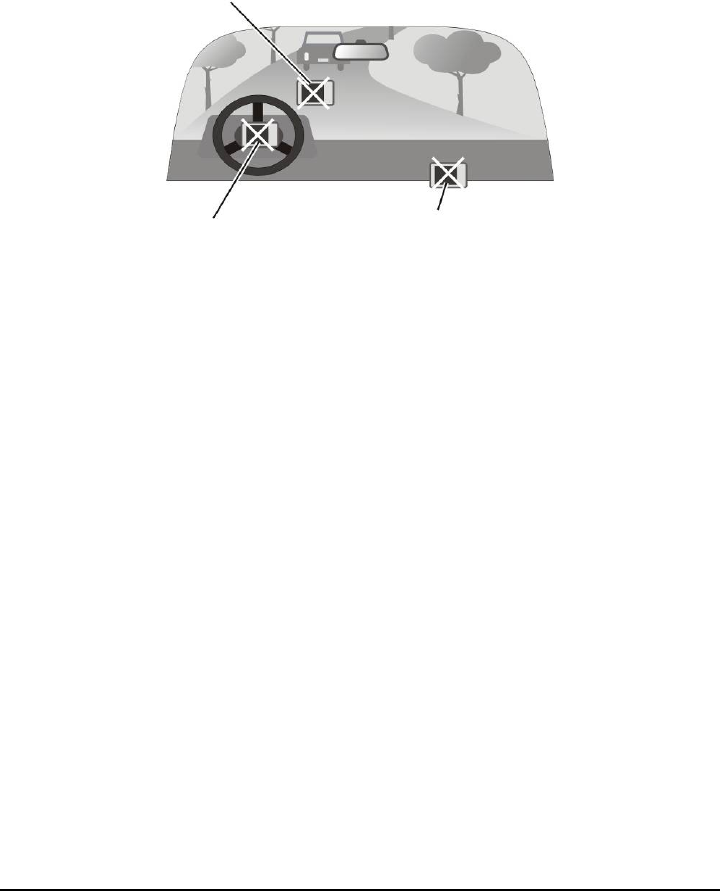
vi
z A device holder is needed when using the device in a car. Be sure to place the
device in an appropriate place, so as not to obstruct the driver’s view, or
deployment of airbags.
Do not mount where the driver’s
field of vision is blocked. Do not place on the
dashboard unsecured.
Do not mount in front of
airbag panels. Do not mount in front of an
airbag field of deployment.
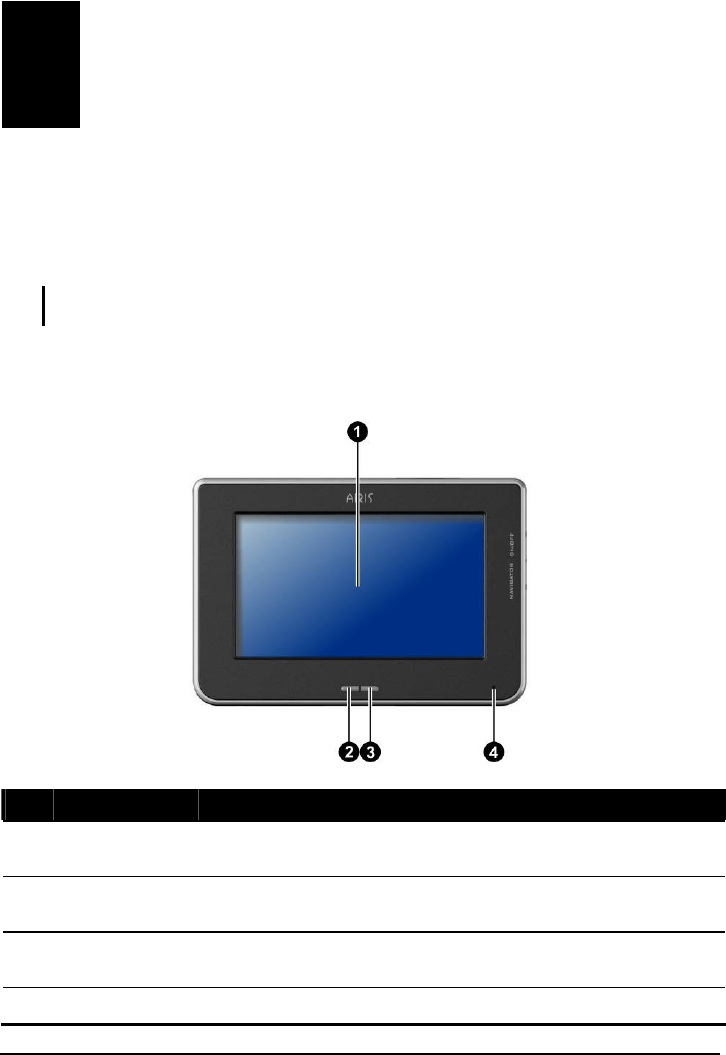
1
1 Getting Started
1.1 Understanding Hardware Components
NOTE: Depending upon the specific model purchased, the color of your device may not
exactly match the device shown in this manual.
Front Components
Ref Component Description
n Touch Screen Displays the output of your device. Tap the screen with your
stylus to select menu commands or enter information.
o Bluetooth
Indicator Flashes in blue to indicate that Bluetooth is on.
p Charge
Indicator Glows bright amber to indicate that the battery is charging, and
turns green when the battery is fully charged.
q Microphone For Bluetooth hands-free calling.
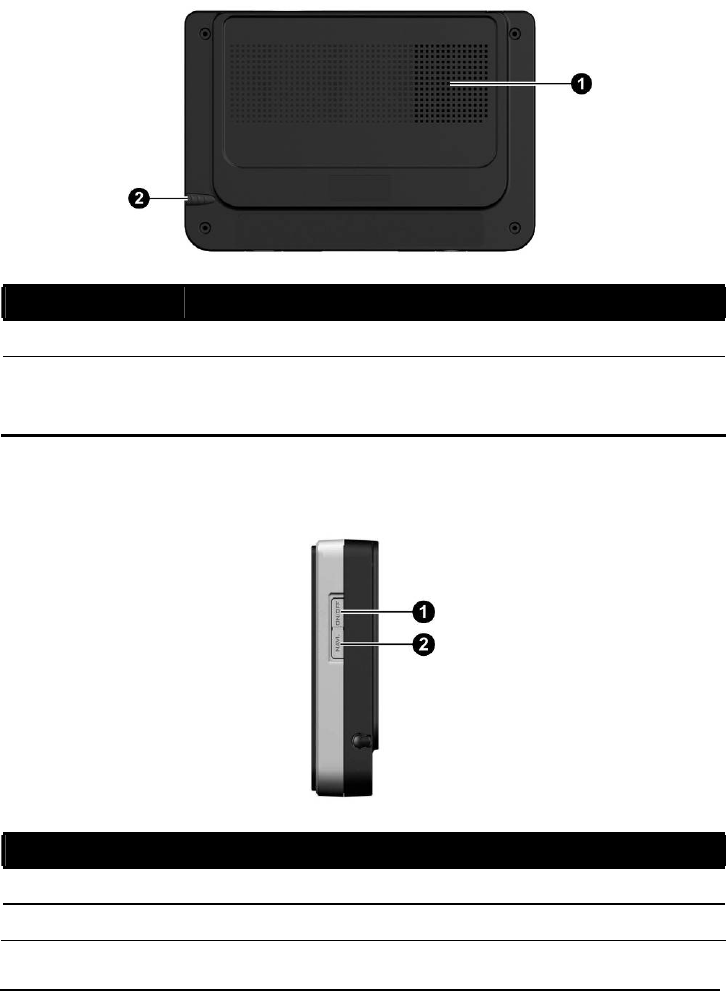
2
Back Components
Ref Component Description
n Speaker Sends out music, sounds and voice.
o Stylus Tap the touch screen to make selections and enter information.
Pull the stylus out of its slot to use it, and store it in the slot when
not in use.
Right-side Components
Ref Component Description
n Power Button Turns on and off the device.
o Navigation Button Starts the navigation software.
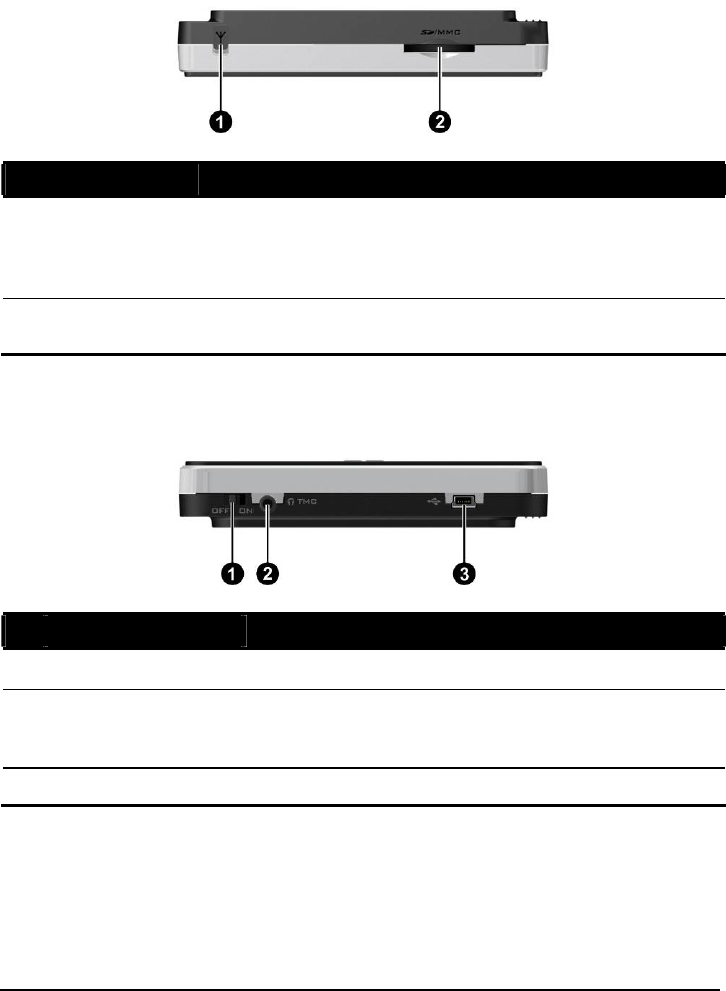
3
Top Components
Ref Component Description
n External
Antenna
Connector
This connector (under rubber dust cover) allows use of an
optional external GPS antenna with magnetic mount, which may
be positioned on top of the car for better GPS signal reception in
areas with poor reception.
o SD/MMC Slot Accepts a SD (Secure Digital) or MMC (MultiMediaCard) card
for accessing data such as pictures.
Bottom Components
Ref Component Description
n ON/OFF Switch The main power/battery cutoff switch.
o Headphone/TMC
Connector Connects to stereo headphones or the TMC (Traffic
Message Channel) antenna for receiving TMC
information.
p Mini-USB Connector Connects to the charger or USB cable.
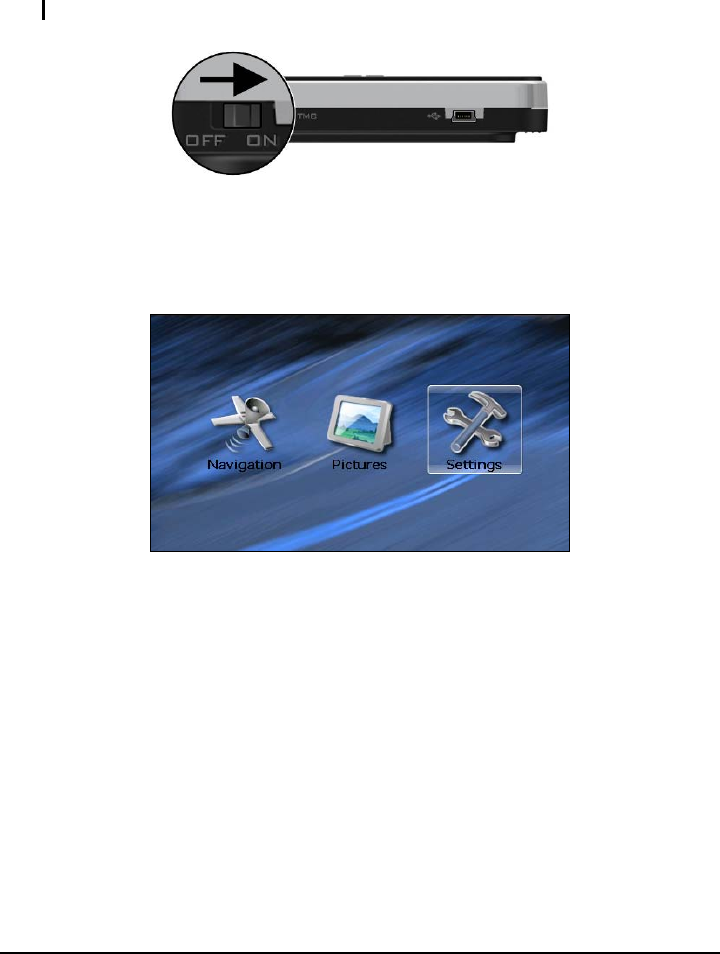
4
1.2 Performing the Initial Start Up
1. Using a pointed pen, slide the ON/OFF switch to the ON position.
CAUTION: Always leave the ON/OFF switch in the ON position for normal operation
2. Your device turns on.
3. The Home screen appears. You can now use your device.
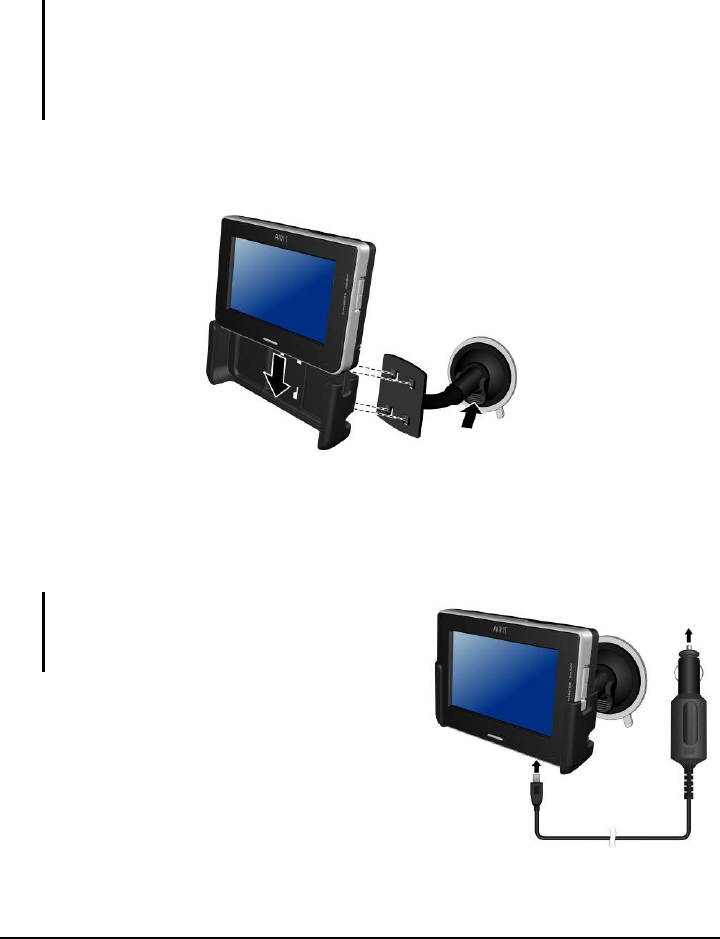
5
1.3 Using Your Device in a Vehicle
Using the Device Holder
CAUTION:
z Select an appropriate location for the device holder. Never place the holder where the
driver’s field of vision is blocked.
z If the car’s windshield is tinted with a reflective coating, an external antenna (optional) may
be needed to route the antenna to the top of the car through a window. When closing the
car window, be careful not to pinch the antenna cable
Use the device holder to fix your device in a vehicle. Make sure that the GPS
antenna has a clear view of the sky.
Connecting the Car Charger
The car charger supplies power to your device when you are using the device in a
car. .
CAUTION: To protect
y
our device a
g
ainst
sudden surges in current, connect the car
charger only after the car engine has been
started.
1. Connect one end of the car charger to the
power connector of your device.
2. Connect the other end to the cigarette
lighter in the car to power and charge your
device. The indicator on the car charger
lights in green to indicate that power is
being supplied to your device.
To Cigarette
L
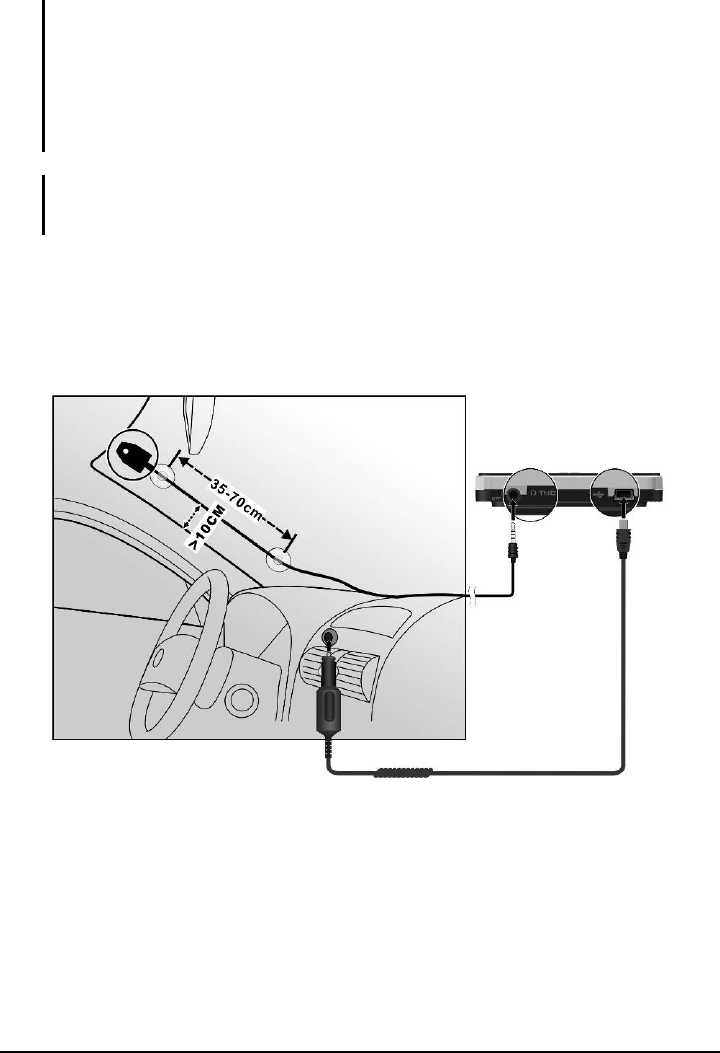
6
CAUTION: For optimal performance of the lithium battery:
z Do not charge the battery where the temperature is high (e.g. in direct sunlight).
z There is no need to fully discharge the battery before charging. You can charge the battery
before it is discharged.
z When storing the product for a long period of time, be sure to fully charge the battery at
least once every two weeks. Over discharge of the battery can affect the charging
performance.
NOTE: Your device can also be charged when it is connected to a desktop computer via the
USB cable. If you intend to charge your device in this way, turn off your device so that it takes
less time to charge the battery.
Connecting the TMC Antenna
TMC antenna allows you to receive radio transmissions that are used to inform
drivers of traffic, weather, and other driving conditions.
TMC information is monitored by the navigation software. Once the information
is received, you can view it on your device and traffic icons will appear in the map
view. Certain roads with reported traffic will be highlighted and you can choose to
avoid those roads and an alternate route will be automatically calculated. (See the
navigation software manual for detailed information.)
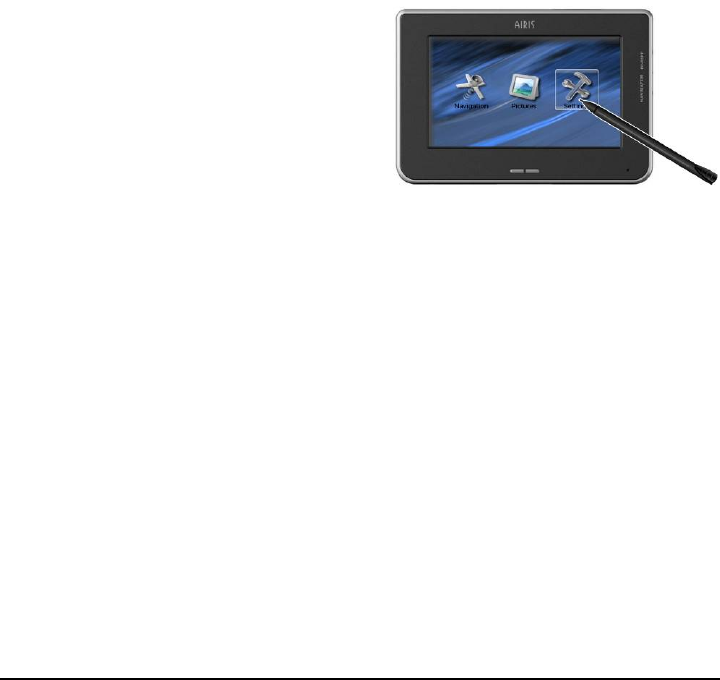
7
1.4 Operating Basics
Turning On and Off
For normal operation, turn off the device by briefly pressing the power button.
The device enters a suspended state.
When you next briefly press the power button, the system resumes. You will
either be back to where you left off or see the Home screen.
Navigating on the Screen
To operate your device, touch the screen with your stylus. You can perform the
following actions:
z Tap
Touch the screen once with your
stylus to open items or select onscreen
buttons or options.
z Drag
Hold your stylus on the screen and
drag up/down/left/right or across the
screen.
z Tap and hold
Tap and hold your stylus until an
action is complete, or a result or menu
is shown.
Home Screen
The first time you initialize your device, the Home screen appears. The Home
screen is your starting place for various tasks. Tap a button to start a task or open
another menu.
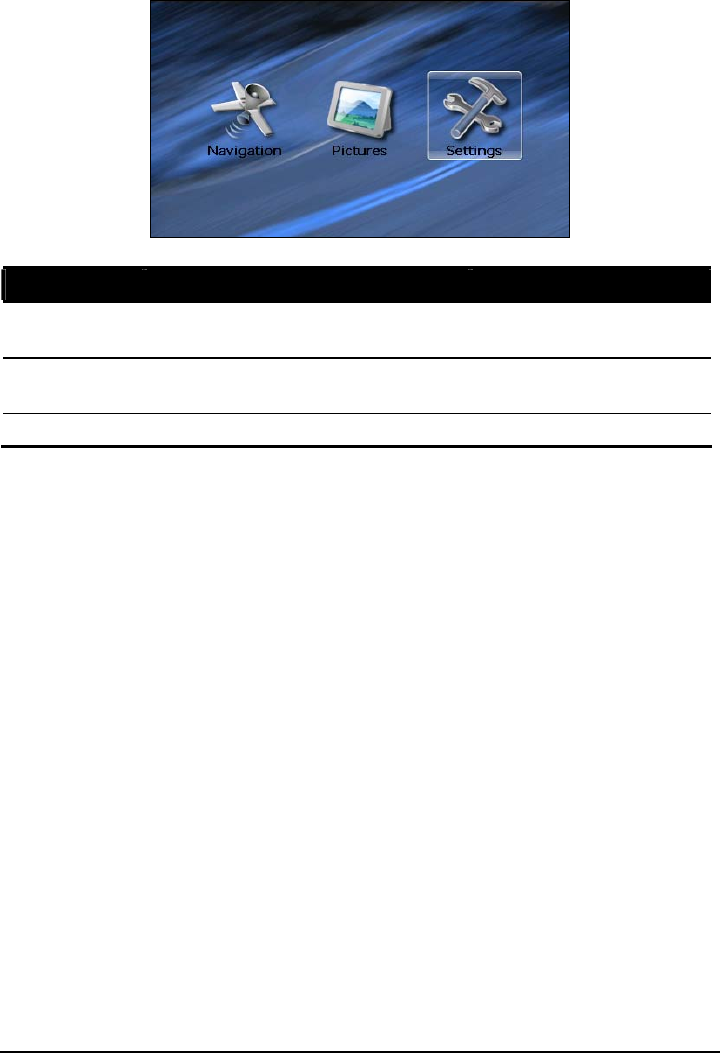
8
Button Name Description For Detailed Information
Navigation Starts the navigation software. See the manual supplied
with the software.
Pictures Displays pictures (.jpg, .gif, and .bmp
formats). Chapter 2
Settings Customizes the system settings. Chapter 3
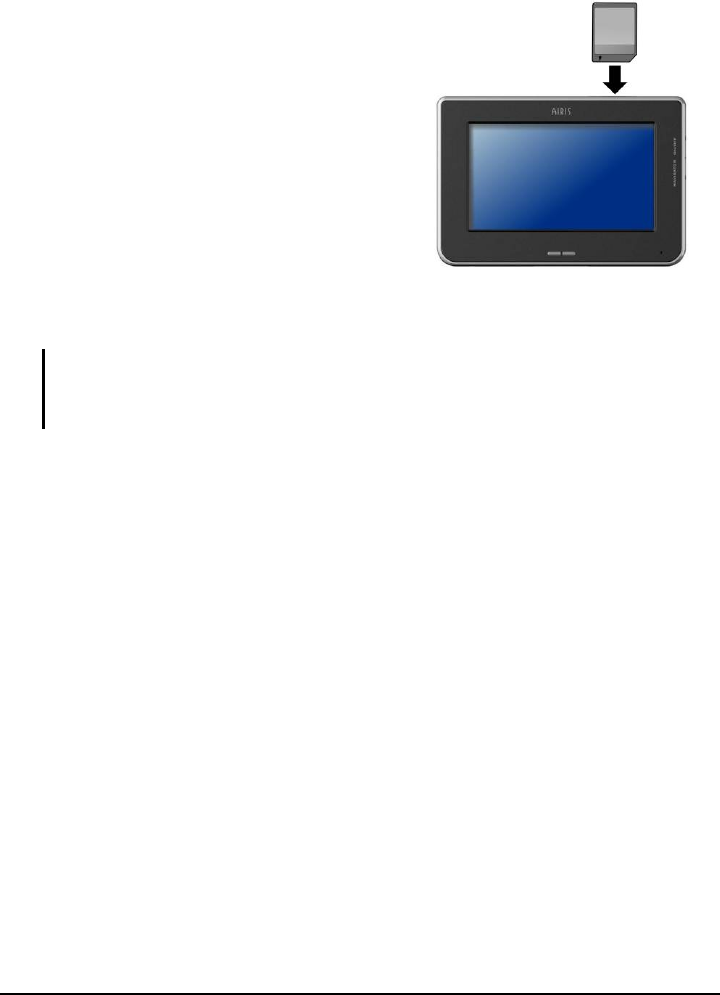
9
1.5 Inserting a SD/MMC Card
Your device has a SD/MMC slot where you
can insert an optional Secure Digital or
MultiMediaCard storage card.
To use a SD/MMC card, insert it into the
slot, with the connector pointing to the slot
and its label facing the front of the device.
To remove a card, first make sure that no application is accessing the card, then
slightly push the top edge of the card to release it and pull it out of the slot.
NOTE:
z Make sure that no foreign objects enter the slot.
z Keep a SD or MMC card in a well-protected box to avoid dust and humidity when you are
not using it.
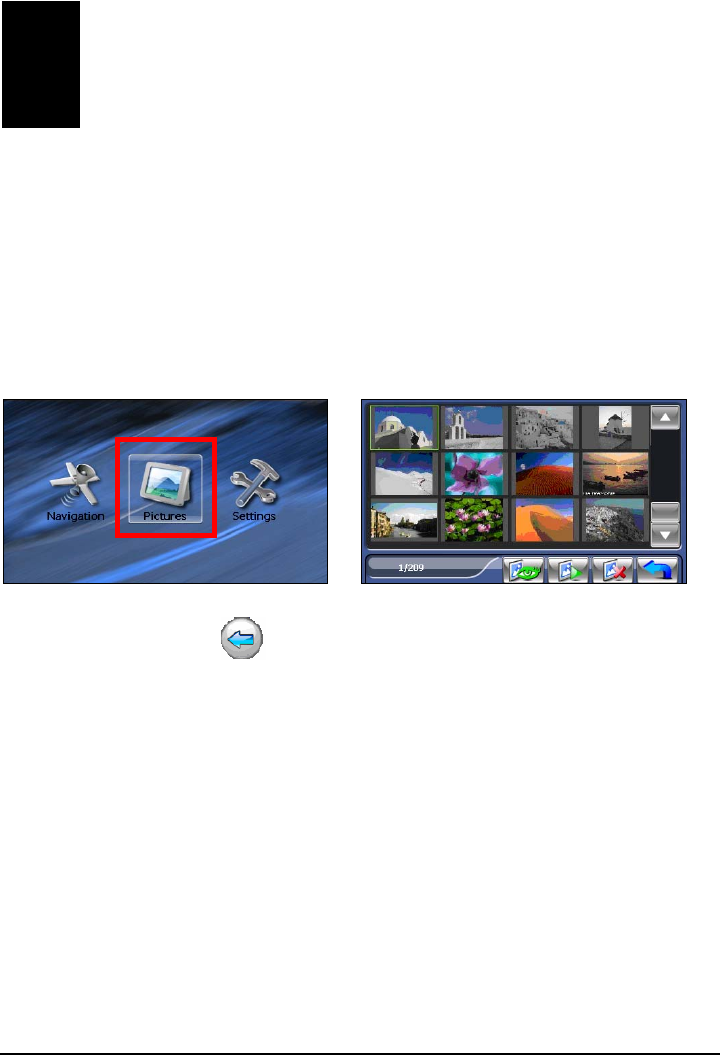
11
2 Pictures
2.1 Starting and Exiting Pictures
Pictures allows you to view pictures in JPEG, GIF and BMP formats and view the
slideshow of the pictures on your device.
Tap the Pictures button on the Home screen to start the program.
Æ
To exit the program, tap .
2.2 Preparing the Pictures for Your Device
Before using the program, have the JPEG/GIF/BMP files ready on either your
device’s flash memory or on a storage card. Use ActiveSync to copy files from
your computer to the correct location. (See Chapter 6 for information.)
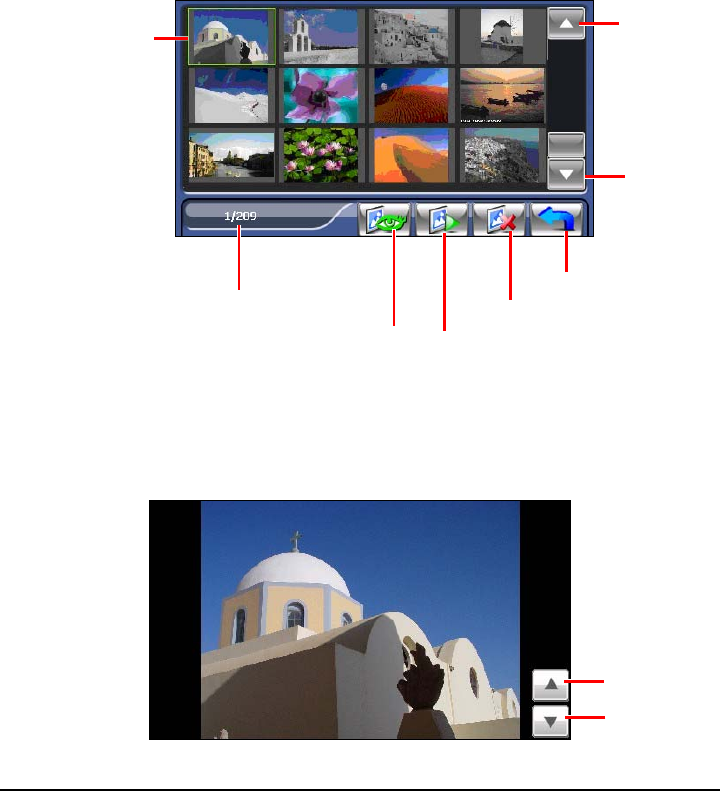
12
2.3 Viewing Pictures in Thumbnail View
1. If your files are in a storage card, insert the card into your device.
2. Tap the Pictures button on the Home screen to start the program.
3. The program will search the matching files in the specific folder on your
device and in all folders on a storage card. It then displays the pictures in the
thumbnail view. You can press the Up or Down arrow button to go to next or
previous page.
2.4 Viewing a Picture in Full Screen
When you tap a picture twice in the thumbnail view, the picture is displayed in full
screen.
Page down
Selected file/
Total number of files
A frame indicates
the picture is
selected.
Page up
Delete the selected picture.
Exit
Open the selected
picture. Start the slideshow.
Next
Previous
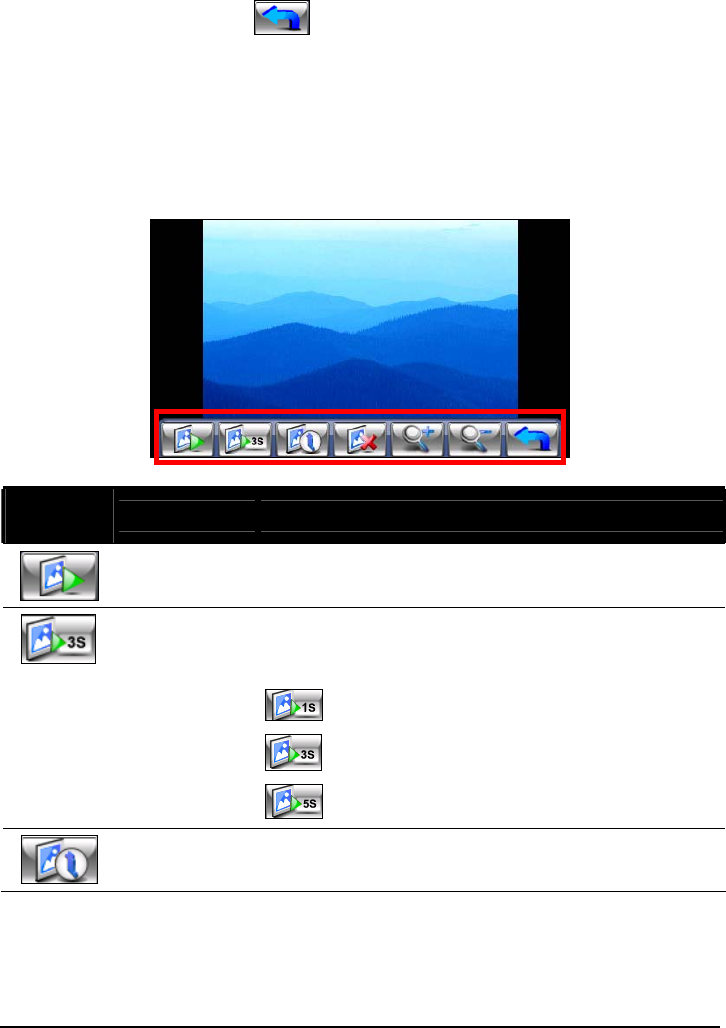
13
To go back to the thumbnail view, tap anywhere on the screen to display the
control buttons and then tap .
2.5 On-Screen Control Buttons
On-screen control buttons provide various functions and settings. Tap anywhere
on the picture to display the buttons as shown below. To close the buttons, tap the
picture again.
Control
Button Name Description
Slideshow Starts the slideshow. (See section 2.6 for detailed
information.)
Interval Sets the length of time each slide is displayed before
moving on to the next slide. Tap the button to switch to
the next available option.
1 second
3 seconds
5 seconds
Information Enables or disables the displaying of the name and date
of the file.
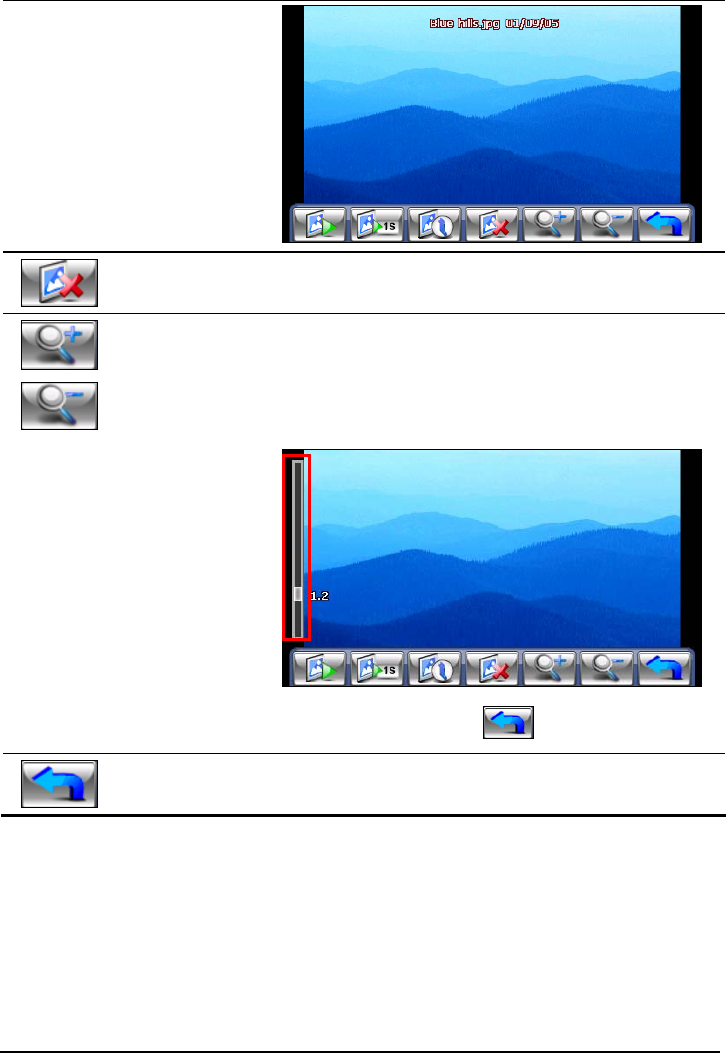
14
Delete Deletes the current picture.
Zoom Opens the zoom bar.
Tap the button as many times as needed to zoom in to
1.2x, 1.5x, 1.8x, or 2.0x. When you have zoomed in the
picture, you can drag the picture to view other parts of
the picture.
To close the zoom bar, tap .
Back Goes back to the thumbnail view.
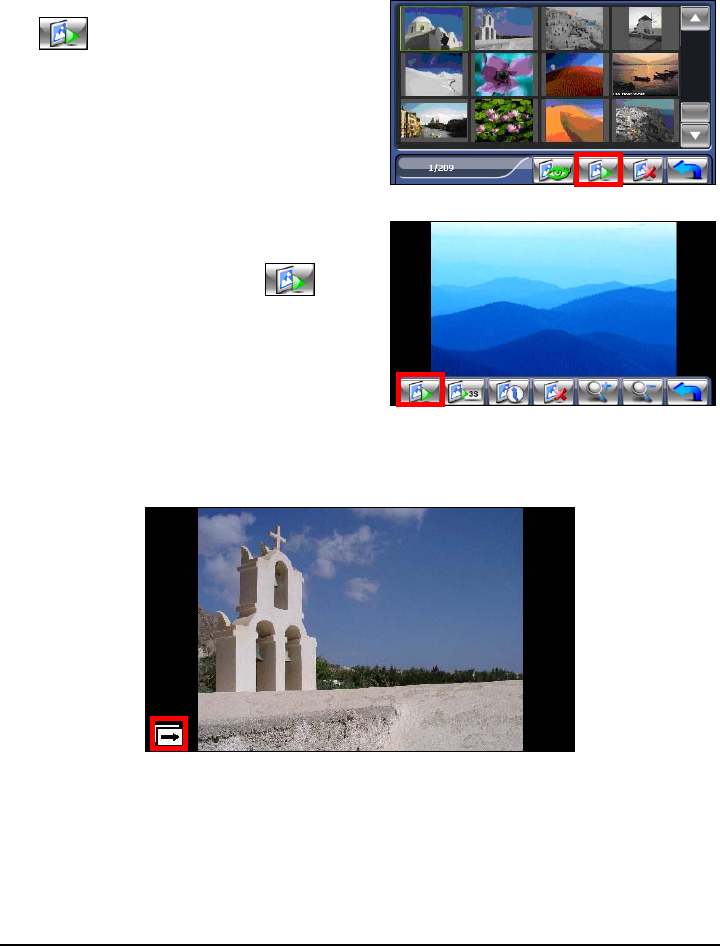
15
2.6 Viewing the Slideshow
To view the slideshow of all your pictures, use one of the following ways:
z When in the thumbnail view, tap
to start the slideshow.
z When in full screen, tap anywhere on
the picture to display the on-screen
control buttons. Then tap to
start the slideshow.
A small triangle at the lower left corner of the screen indicates that the slideshow
is on. To stop the slideshow, tap anywhere on the screen.
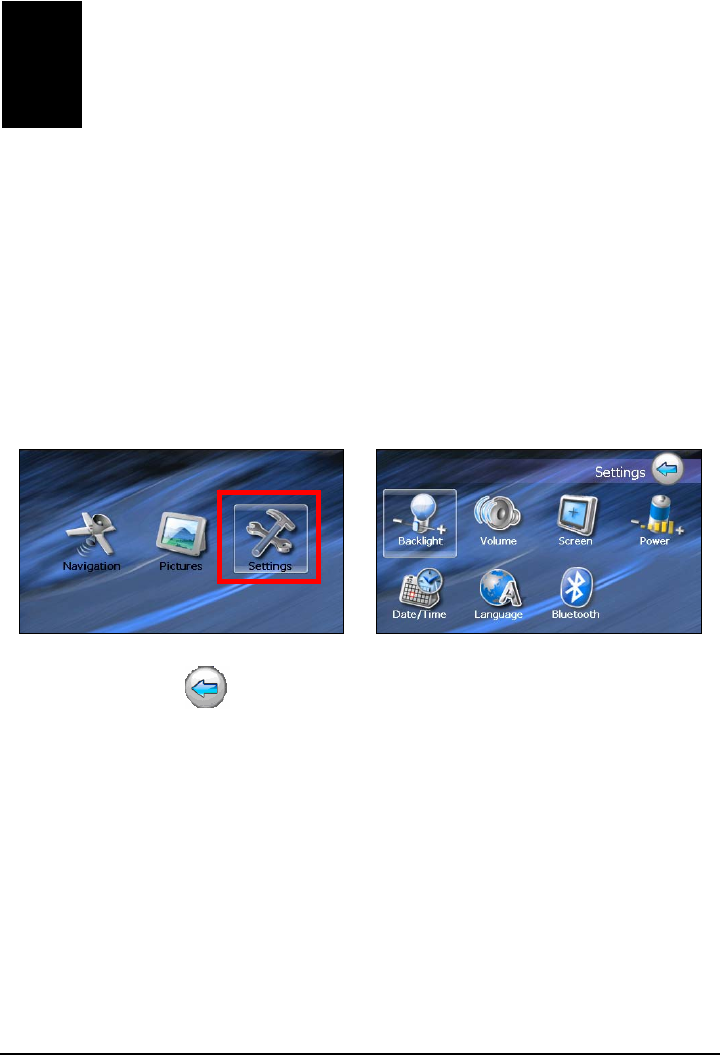
17
3 Settings
3.1 Starting and Exiting Settings
You can customize the system settings such as backlight brightness, volume, and
language. Once you change the settings, the new settings will remain until you
change them again.
Tap the Settings button on the Home screen. The Settings menu appears as shown
below.
Æ
To exit Settings, tap .
The following sections describe the various buttons and their functions.
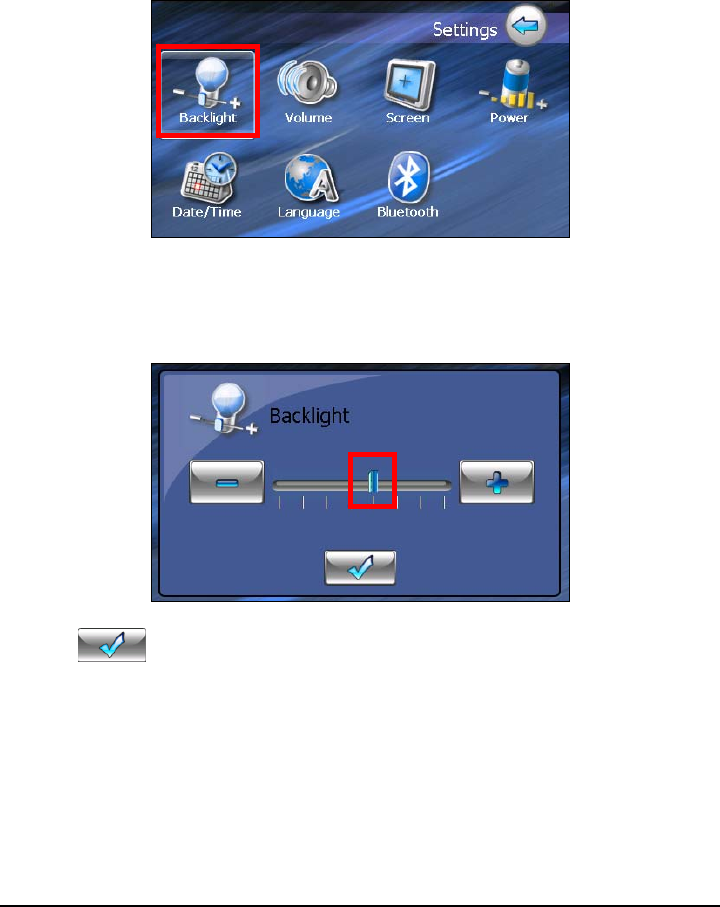
18
3.2 Backlight
1. Tap the Settings button on the Home screen.
2. Tap the Backlight button.
3. Move the knob along the track bar to adjust the brightness of the backlight. To
darken the backlight, move the knob to the left. To lighten the backlight,
move the knob to the right.
4. Tap to save the changes.
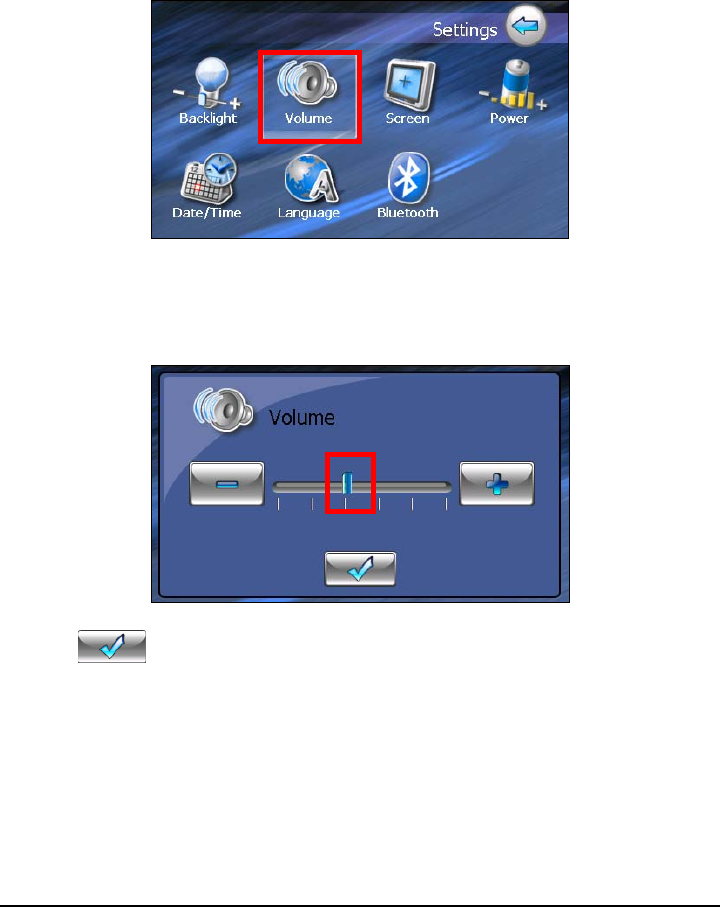
19
3.3 Volume
1. Tap the Settings button on the Home screen.
2. Tap the Volume button.
3. Move the knob along the track bar to adjust the volume. To decrease the
volume, move the knob to the left. To increase the volume, move the knob to
the right.
4. Tap save the changes.
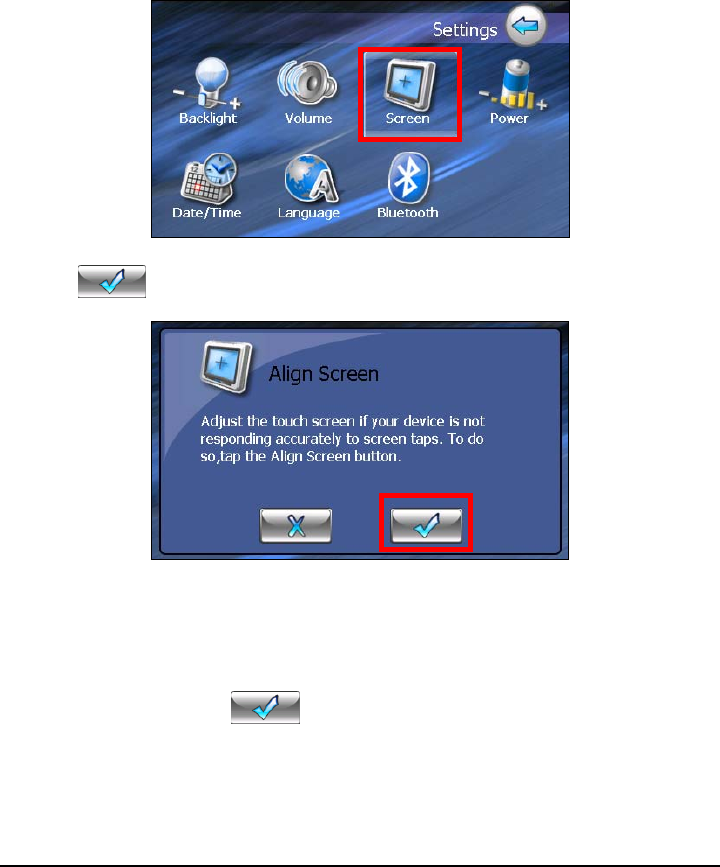
20
3.4 Screen
You can calibrate the touch screen if it is not responding accurately to your taps.
1. Tap the Settings button on the Home screen.
2. Tap the Screen button.
3. Tap to start the calibration.
4. Tap and hold the centre of the target.
5. When the target moves to another position, tap and hold the centre of the new
target. Repeat each time to complete the calibration process.
6. When completed, tap .
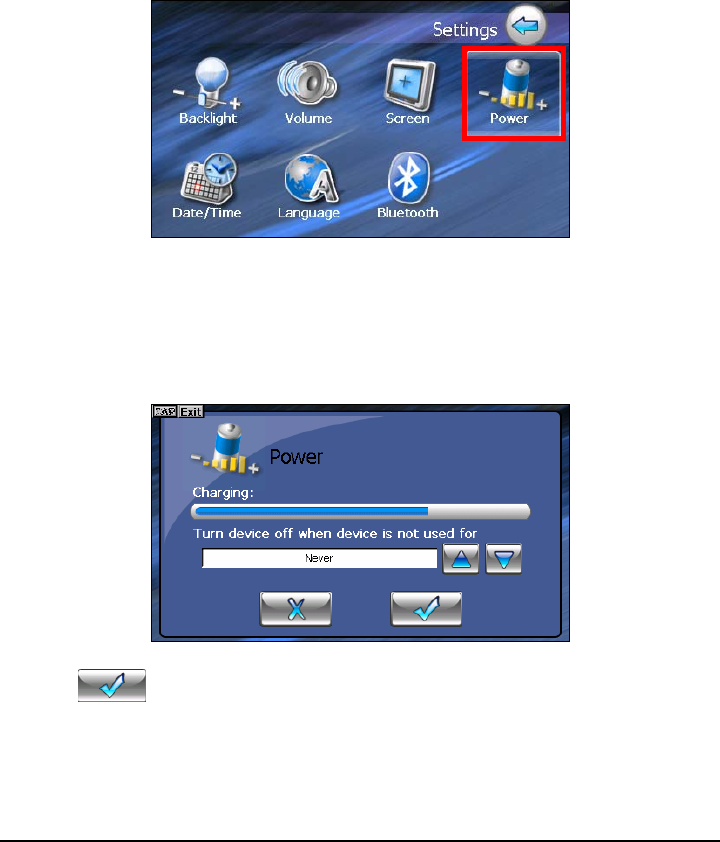
21
3.5 Power
To check the remaining power level of your battery and/or set up the power saving
feature:
1. Tap the Settings button on the Home screen.
2. Tap the Power button.
3. The screen shows the remaining power of your battery.
You can set a timer to automatically turn off your device when it is idle for a
set period of time. The options include Never, 30 minutes, 20 minutes, and
10 minutes.
4. Tap to save the changes.
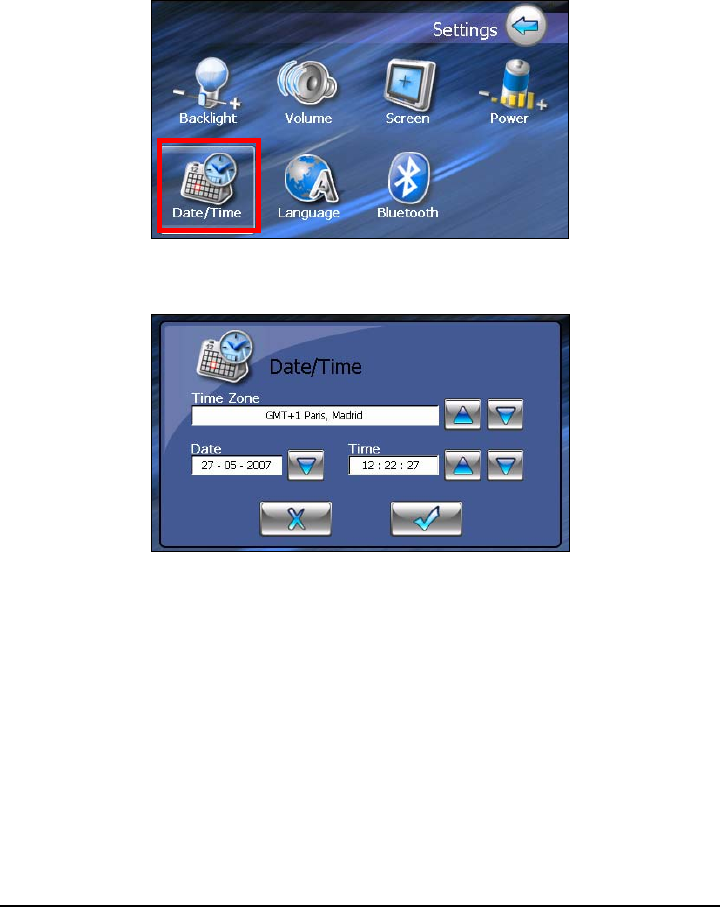
22
3.6 Date&Time
1. Tap the Settings button on the Home screen.
2. Tap the Date&Time button.
3. To change the time zone, tap the left/right arrow in the “Time Zone” item.
4. To change the date, tap the down arrow in the “Date” item. A calendar pops
up. Tap the left arrow on the calendar to go to the earlier month and year or the
right arrow to the later month and year. Alternatively, you can tap the month
or year on top of the calendar to directly change the month or year.
When the calendar shows the current month, tap the date on the calendar.
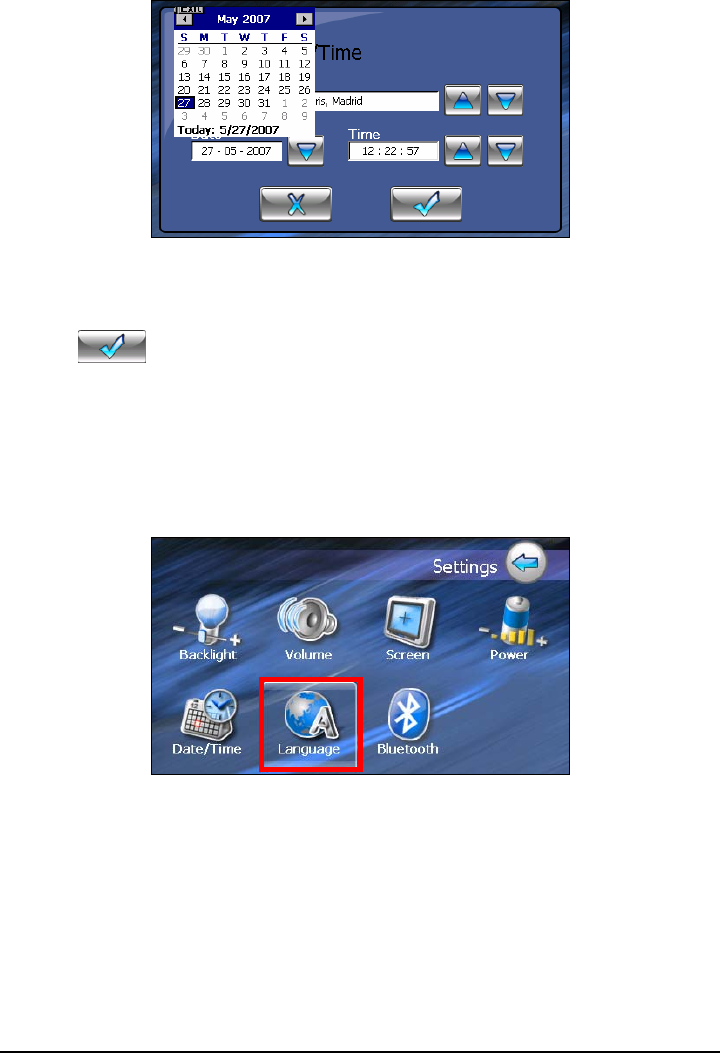
23
5. To set the time, first tap the hour, minute, or second in the “Time” item and
then tap the up arrow to increase or down arrow to decrease the value.
6. Tap to save the changes.
3.7 Change Language
1. Tap the Settings button on the Home screen.
2. Tap the Change Language button.
3. Tap the left/right arrow button to select the desired language.
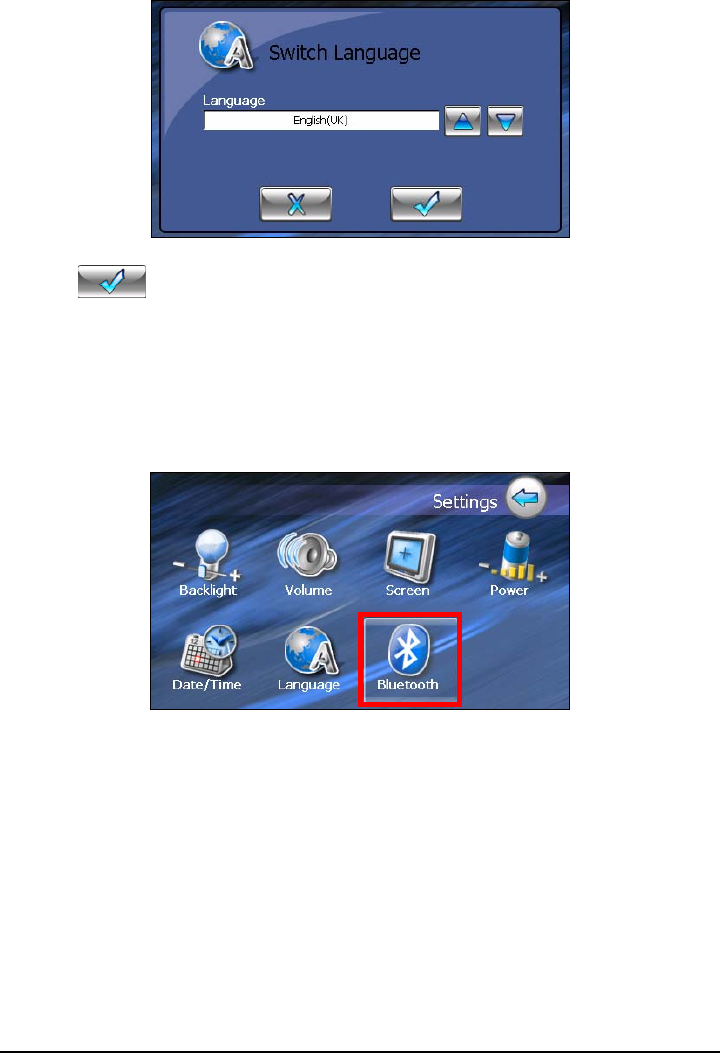
24
4. Tap to save the changes.
3.8 Bluetooth
1. Tap the Settings button on the Home screen.
2. Tap the Bluetooth button.
3. See the next two chapters for detailed information on using Bluetooth®
connectivity.
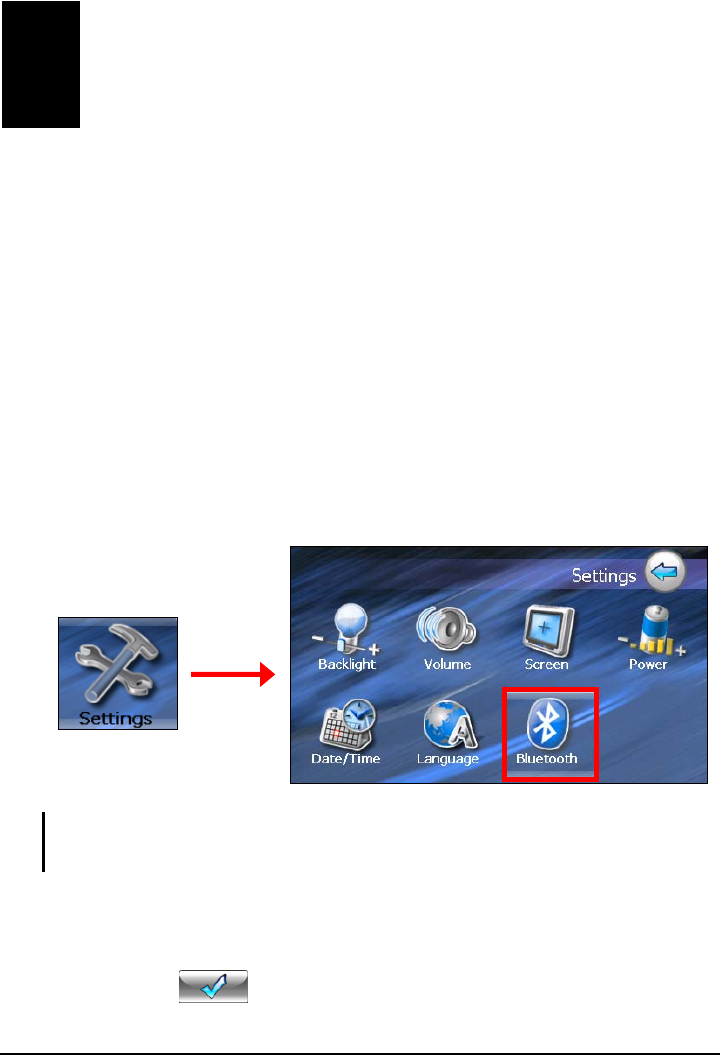
25
4 Bluetooth HF Phone
4.1 About Bluetooth HF Phone
Your device can serve as a hands-free (HF) device for a Bluetooth mobile phone.
After establishing the Bluetooth connection, you can tap your device to place and
receive phone calls instead of picking up the mobile phone, and can use the
built-in speakers and microphone for your conversation.
4.2 Pairing with a Mobile Phone
1. Tap the Settings button on the Home screen and then the Bluetooth button. The
Bluetooth radio turns on.
NOTE: The below procedure describes the scenario when you initiate the Bluetooth
connection from your mobile phone. You can also initiate the Bluetooth connection from your
device. (See section 5.4 for information.)
2. When the Keypad screen appears, you can dial a phone number. The
connection with a Bluetooth mobile phone is required. (See the following
steps for information.)
Or, you can tap to go to the Bluetooth HF Phone main screen.
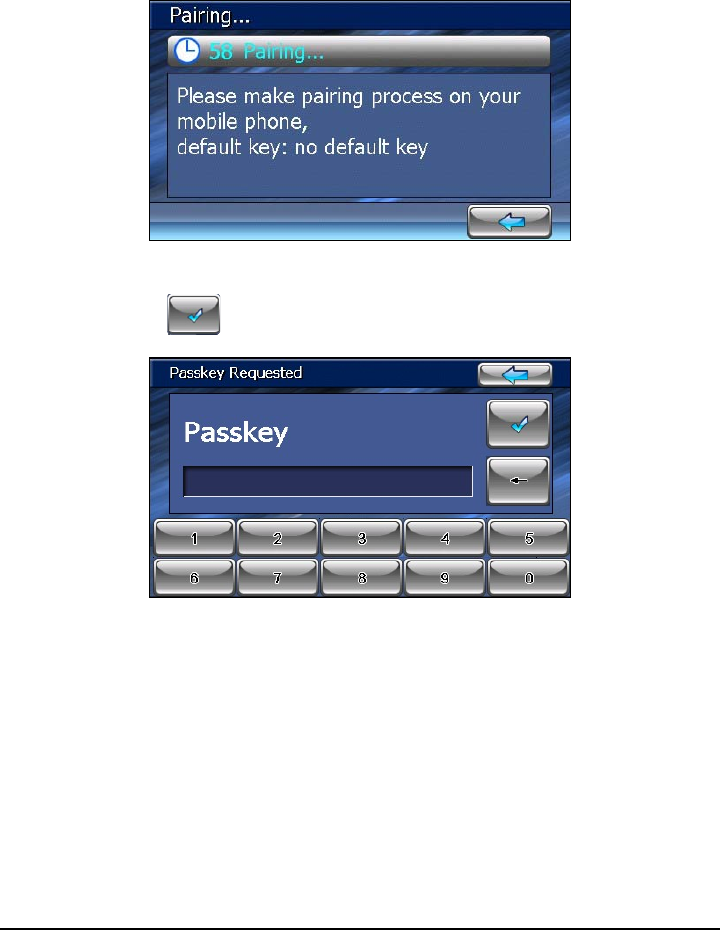
26
3. If this is the first time you use the program, your device will switch to Pair
Mode and wait for the pairing action from your mobile phone for 60 seconds.
The connection will be established as long as you initiate the pairing process
on your mobile phone within this period.
4. If prompted to enter the passkey, tap the passkey specified by the mobile
phone and tap .
5. You will see the Bluetooth HF Phone main screen after the pairing is
completed. The status bar at the bottom shows the name of the mobile phone
connected.
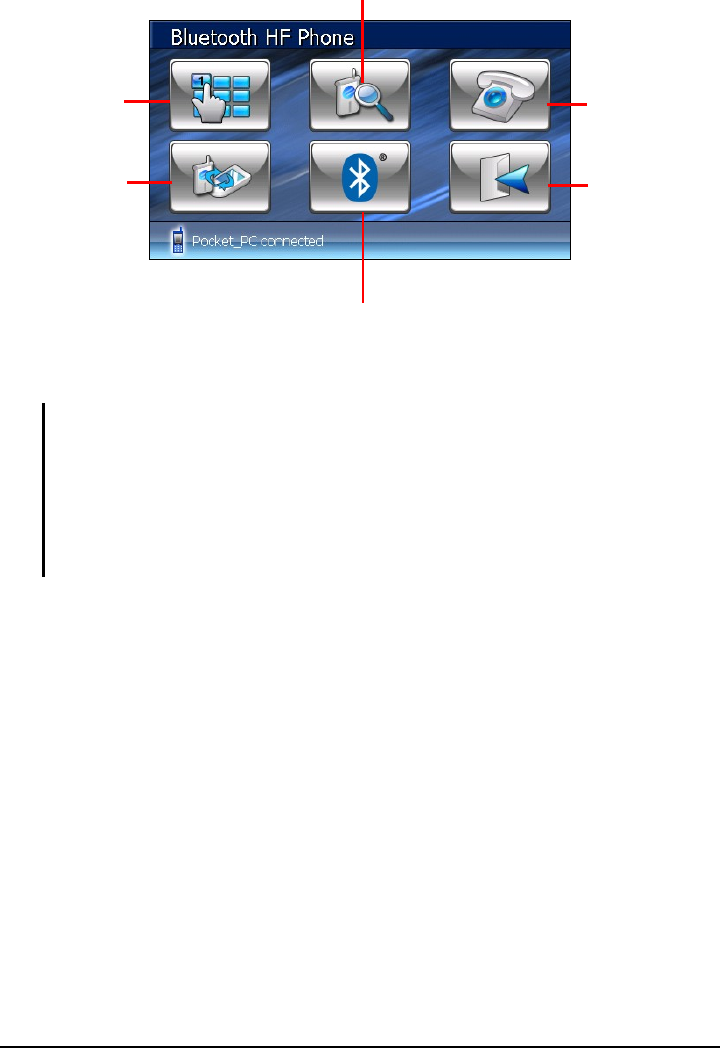
27
The next time you run the program, your device will automatically search and pair
with one of the last connected mobile phones.
NOTE:
z Your device must be in Pair Mode for the mobile phone to discover your device. If you
need to manually set your device to Pair Mode, tap Pair Mode on the main screen.
z Some mobile phones can automatically connect the hands-free service.
z Up to 8 sets of paired mobile phones can be stored. A 9th paired mobile phone will replace
the oldest one.
z The Bluetooth HF Phone program cannot access the data such as the phone book and
call history stored in a connected mobile phone.
Exit (Minimize)
Call History
Keypad
Reconnect
Pair Mode
Bluetooth Manager
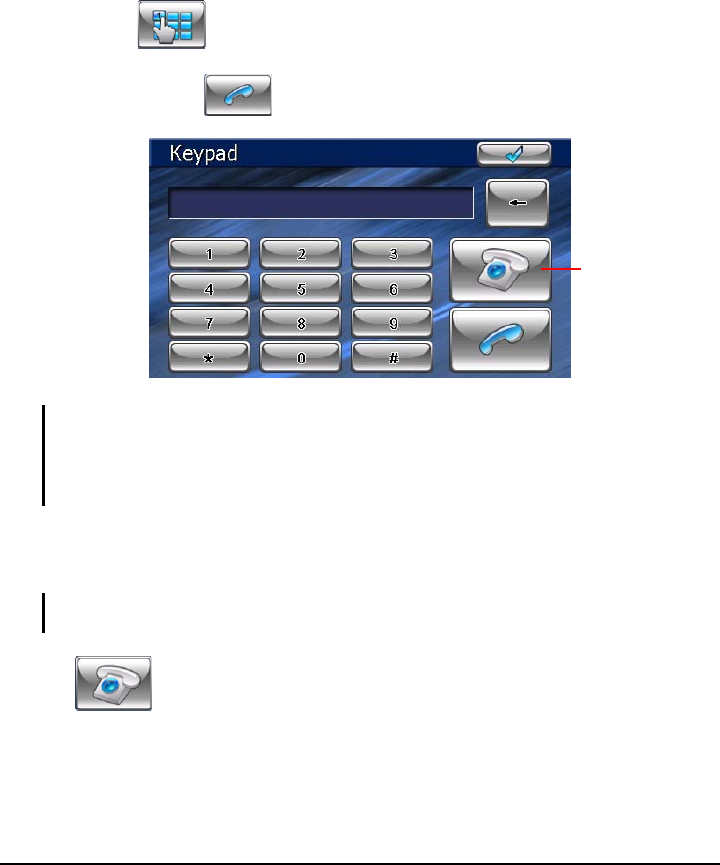
28
4.3 Placing a Call
After pairing with your mobile phone, you can place a call using the Keypad or Call
History button on the Bluetooth HF Phone main screen.
Keypad
By tapping the Keypad button on the Bluetooth HF Phone main screen,
you can enter the telephone number with the onscreen keypad. After entering the
telephone number, tap to place the call.
NOTE:
z International calls require a country code to be included in the phone number. On your
device, the country code is separated from the rest of the number sequence by a plus (+)
sign. If you are making an international call, tap and hold the * key until the + sign appears.
z To delete the last digit entered, tap the Backspace button.
Call History
NOTE: Bluetooth HF Phone cannot access the call history stored in a connected mobile
phone.
Tap the Call History button on the Bluetooth HF Phone main screen to
display the recent incoming, outgoing, or missed calls together with information
such as date, time, and duration of each call.
Call History
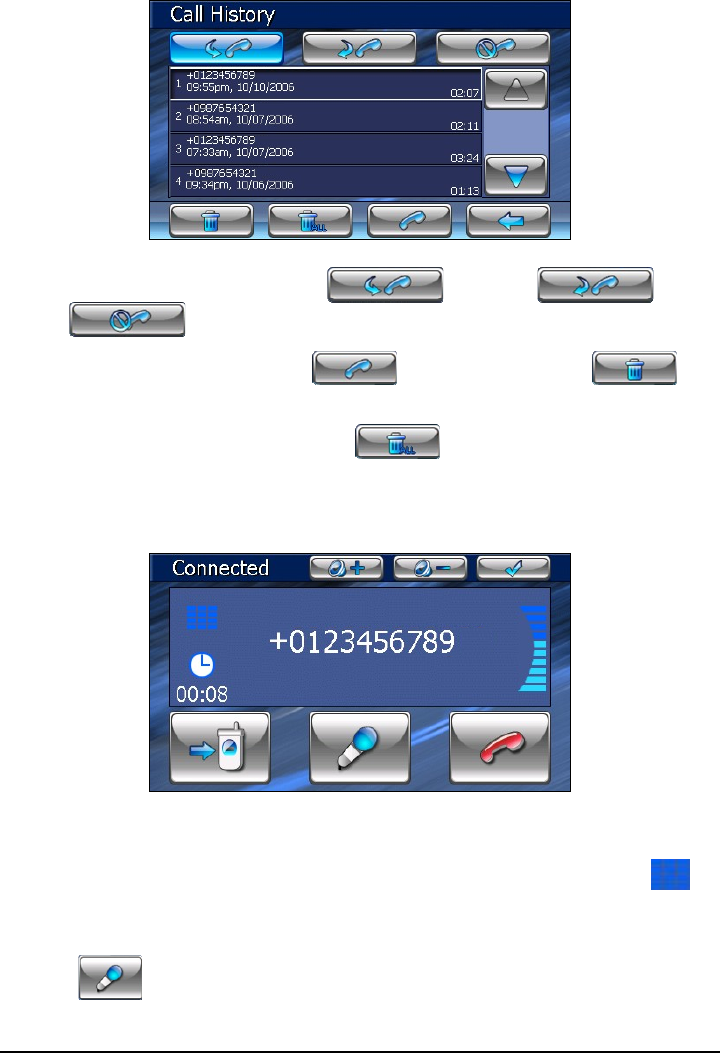
29
Tap the respective button (incoming , outgoing , or
missed ) to view the last 20 calls of the selected type.
With an item selected, you can tap to dial the number or to
delete the item.
To clear all items in the current list, tap .
4.4 Operations during a Call
During a phone call:
z If you need to input other numbers, such as an extension number, tap to
open the keypad and tap the digits. The keypad will close when you tap the
button again or when there has been no input for 5 seconds.
z Tap to mute your sound so that the other party cannot hear you. To
end the mute mode, tap the same button again.
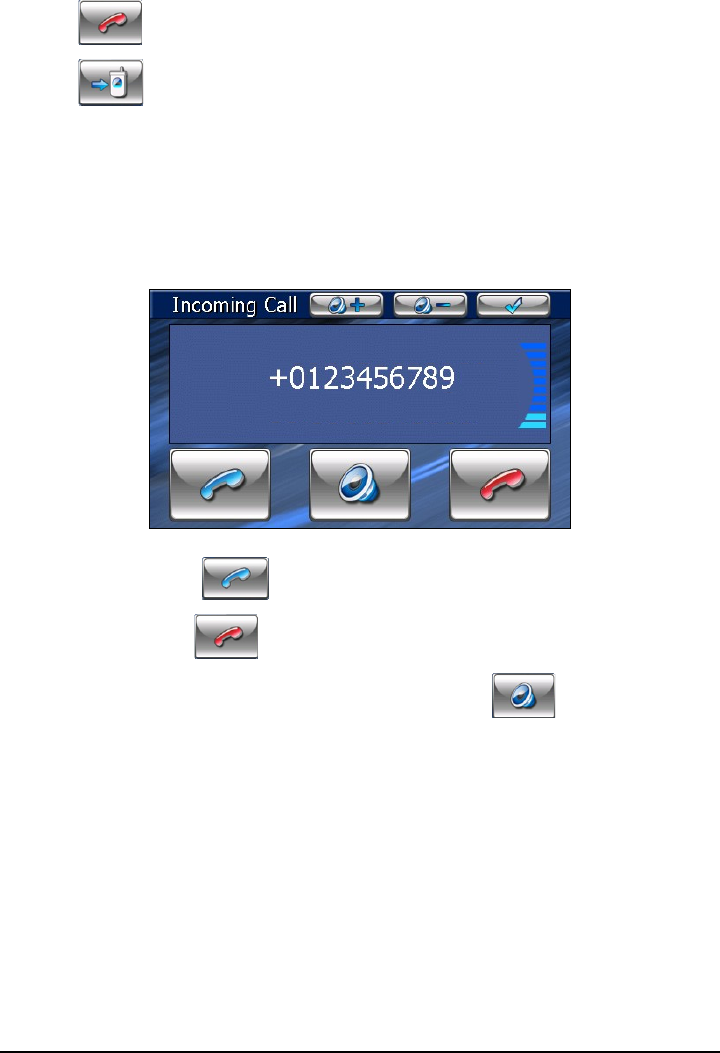
30
z Tap to end the call.
z Tap to switch the call to your mobile phone. To switch back to your
device, tap the same button again.
4.5 Receiving a Call
When you have a call after pairing with a mobile phone, the device rings and
displays the Incoming Call screen.
To accept the call, tap .
To reject the call, tap .
To mute the ring tone before receiving or rejecting, tap .
4.6 Miscellaneous Buttons
In addition to buttons for placing a call, there are Connect, Pair Mode, Bluetooth
Manager, and Exit buttons on the Bluetooth HF Phone main screen as described
below.
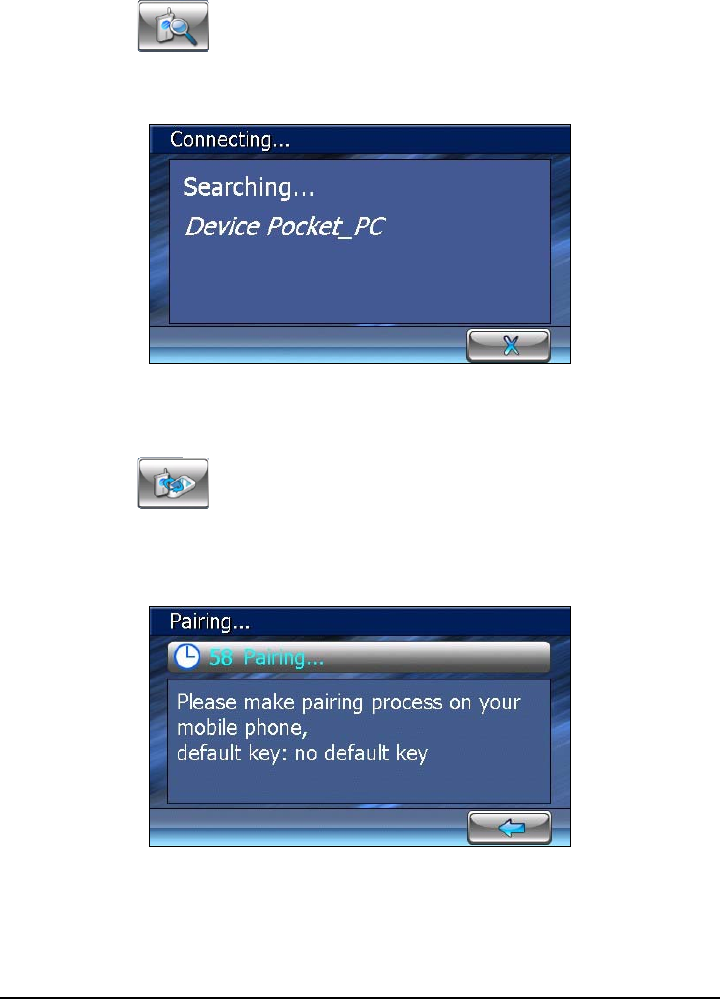
31
Connect
By tapping the Connect button on the Bluetooth HF Phone main screen,
you can manually search the last paired mobile phones for an available
connection.
Pair Mode
By tapping the Pair Mode button on the Bluetooth HF Phone main screen,
you can manually set your device to Pair Mode. Within the duration of 60
seconds, you can initiate the pairing process on your mobile phone to discover
your device as a hands-free device.
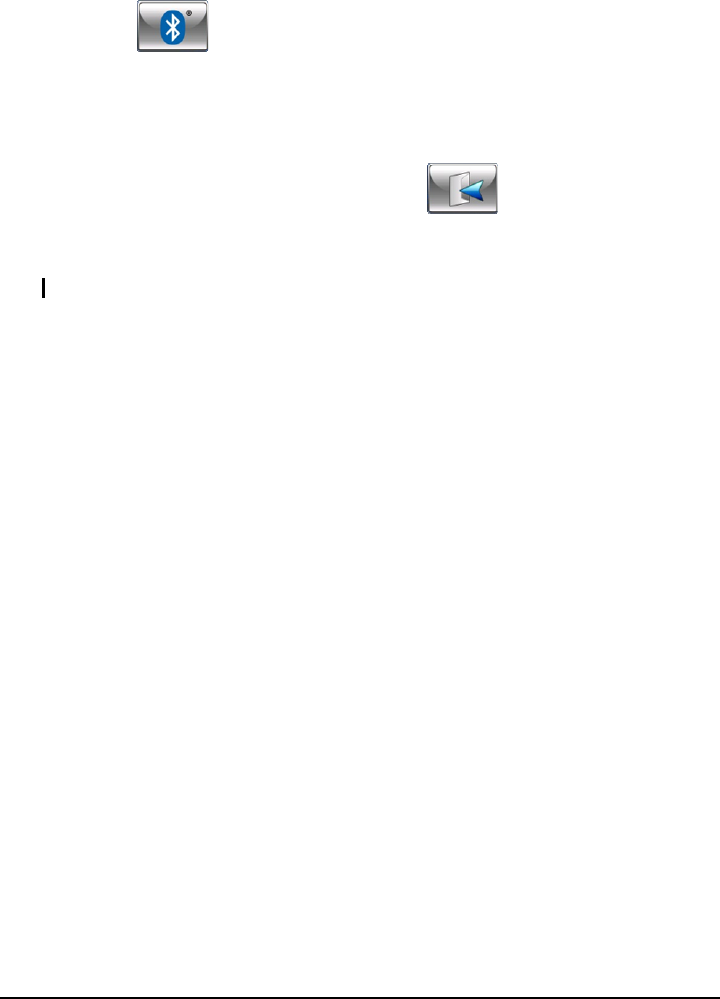
32
Bluetooth Manager
By tapping the Bluetooth Manager button on the Bluetooth HF Phone main
screen, you can run the Bluetooth Manager program. (See Chapter 5 for
information on Bluetooth Manager.)
Exit
To hide the Bluetooth HF Phone screen, tap the Exit button on the
Bluetooth HF Phone main screen. Bluetooth HF Phone is still running in the
background
NOTE: To know how to turn off Bluetooth radio, see section 5.3.
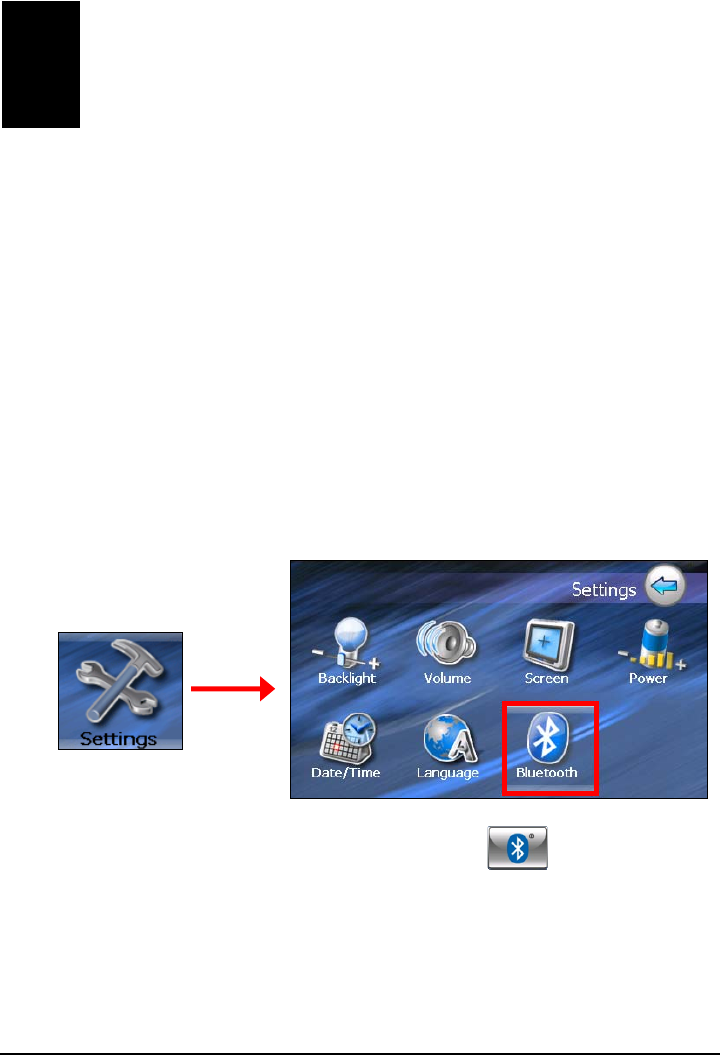
33
5 Bluetooth Manager
5.1 About Bluetooth Manager
Your device incorporates Bluetooth wireless communications technology.
Devices with Bluetooth capabilities can exchange information over a distance of
about 10 meters (30 feet) without requiring a physical connection.
Bluetooth Manger allows you to configure and use the Bluetooth capabilities of
your device.
5.2 Starting and Exiting Bluetooth Manager
1 Tap the Settings button on the Home screen and then the Bluetooth button.
2 When the Bluetooth HF Phone screen appears, tap .
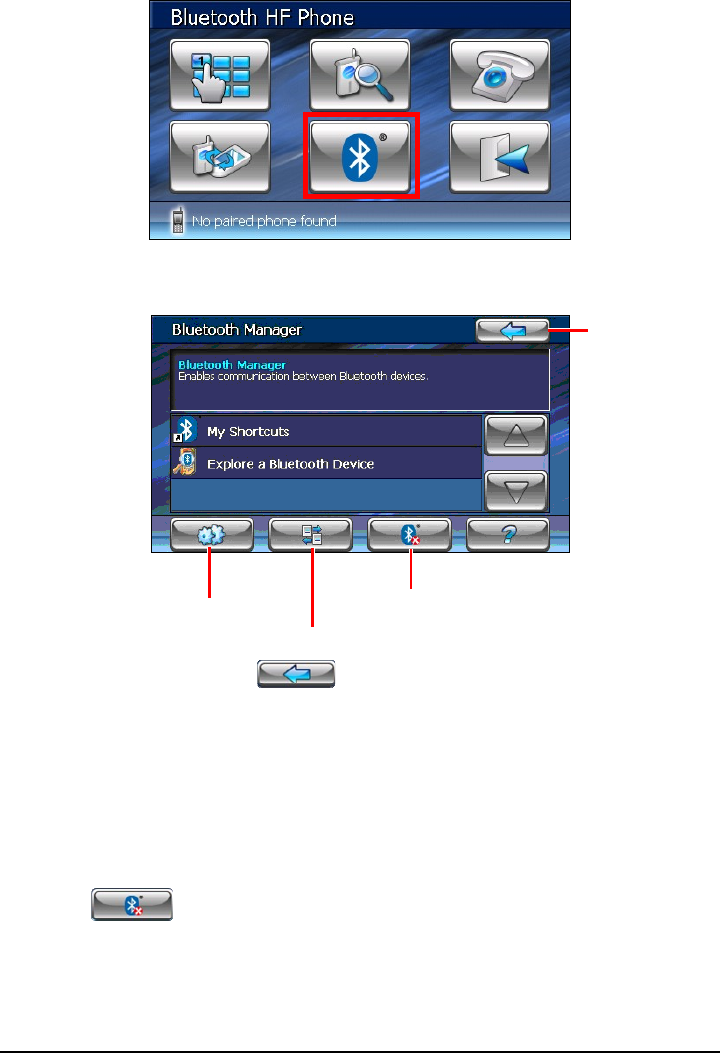
34
3 The Bluetooth Manager screen appears as shown below.
4 To exit the program, tap . You will be back to the Bluetooth HF
Phone screen.
5.3 Turning On/Off Bluetooth Radio
Whenever you start Bluetooth Manager, Bluetooth radio is turned on. The
Bluetooth indicator on your device flashed in blue.
Exiting Bluetooth Manager doesn’t turn off Bluetooth radio. To turn off Bluetooth
radio, tap in the Bluetooth Manager screen. The flashing Bluetooth
indicator goes off.
Bluetooth Settings
Exit
Turn off Bluetooth radio.
A
ctive Connections
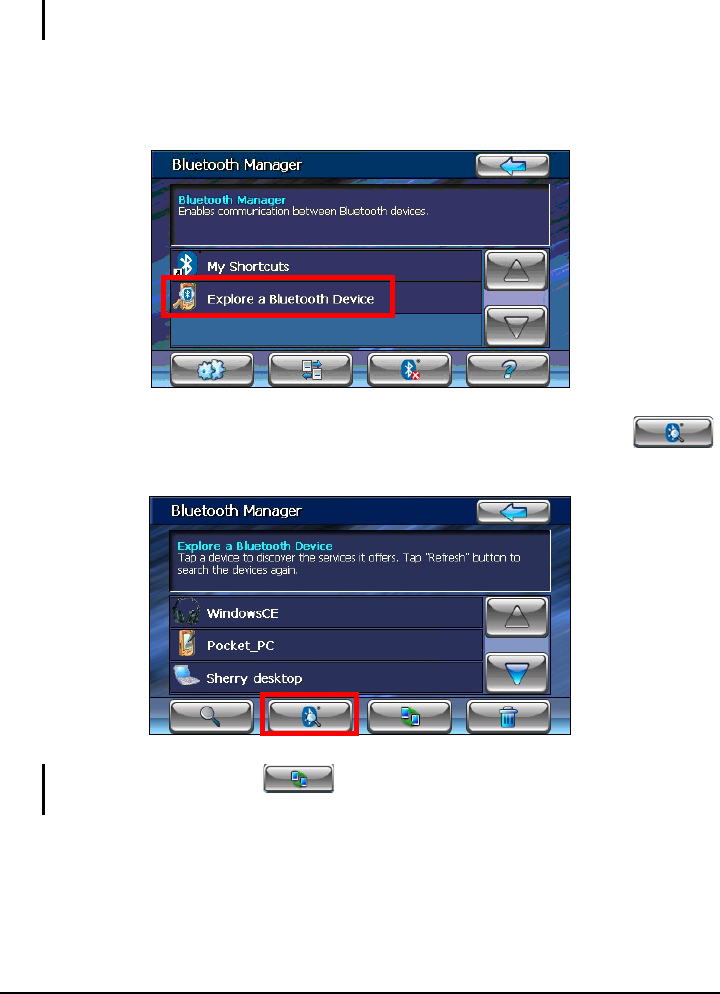
35
5.4 Exploring Devices
NOTE: To use the service of a remote device with Bluetooth capability, make sure that the
remote device is in discoverable mode.
1 Start Bluetooth Manager as described in section 5.2.
2 Tap Explore a Bluetooth Device to search for nearby devices.
3 The device list appears on the screen. Tap the target device and tap
to browse the services of the device.
NOTE: You can also tap the button to pair with the selected device before
browsing its services.
4 Tap the service you want to use.
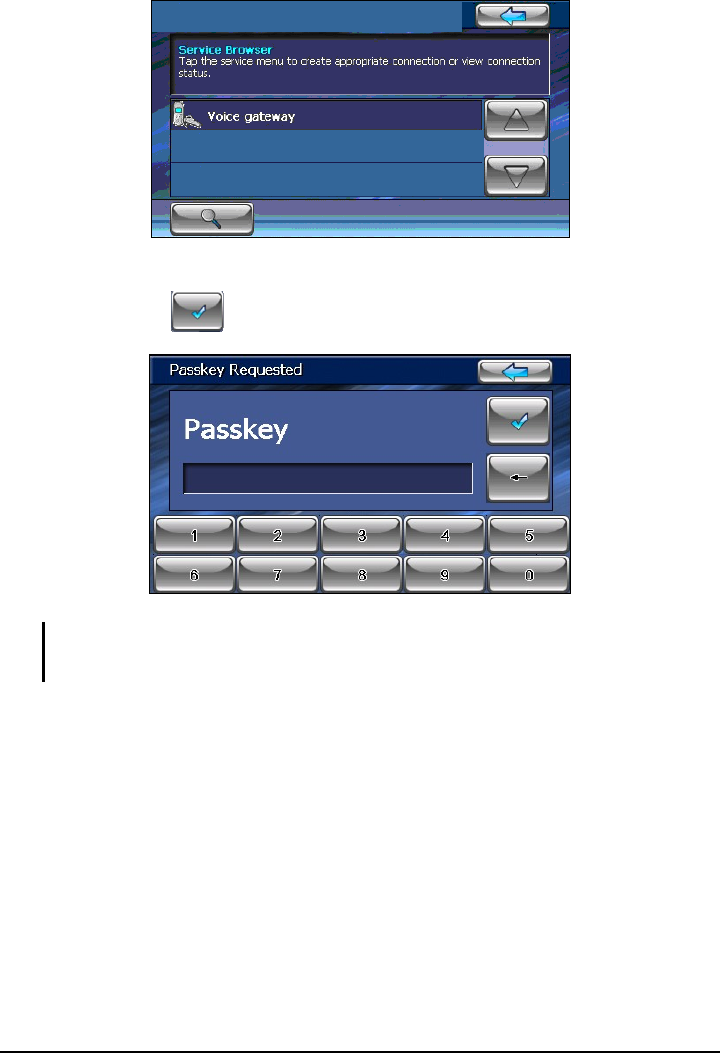
36
5 When prompted to enter the passkey, tap the passkey requested by the target
device and tap .
NTOE: Once you have established a Bluetooth connection with a remote device, it will be
saved as a shortcut. You can then use My Shortcuts to conveniently use the same service
again. (See section 5.6 for information.)
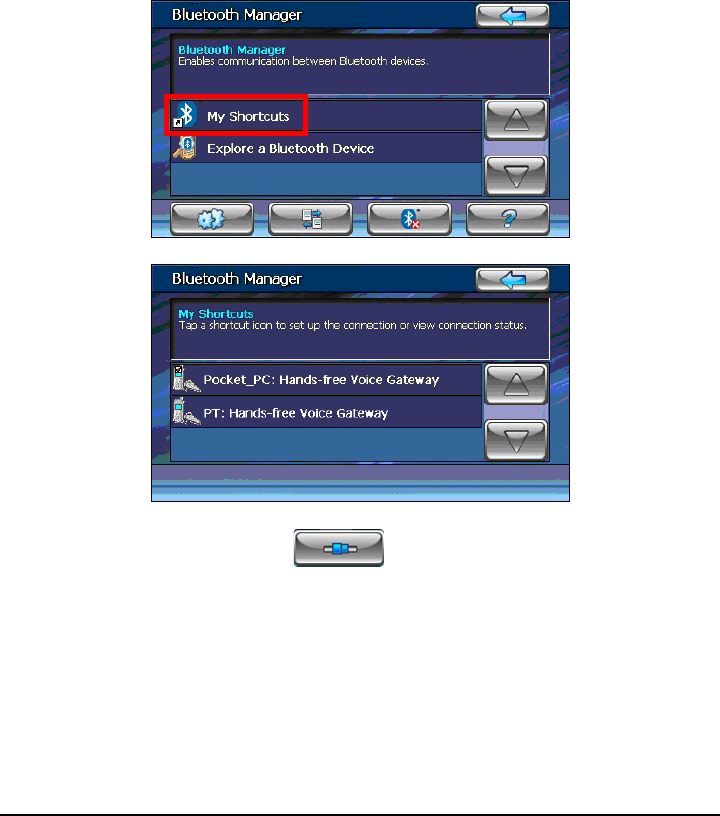
37
5.5 Using My Shortcuts
Once you have established a Bluetooth connection with a remote device, it will be
saved as a shortcut. My Shortcuts allows you to conveniently use the same service
again by tapping the particular shortcut item.
1 Start Bluetooth Manager as described in section 5.2.
2 Tap My Shortcuts.
↓
3 Tap the desired item and tap to establish a connection again.
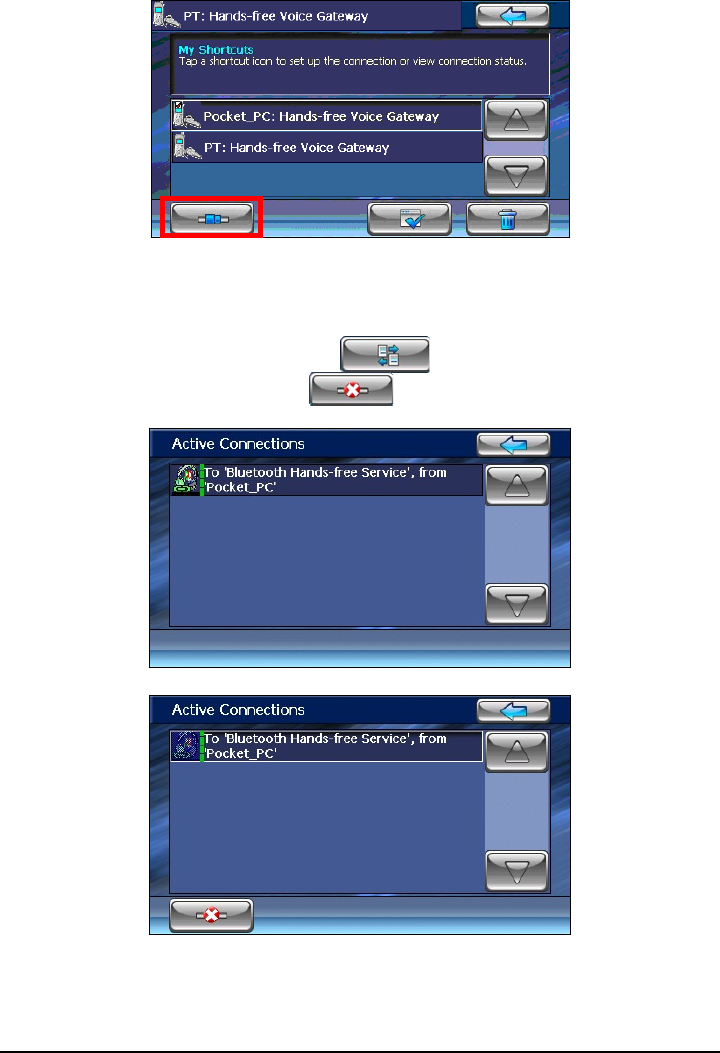
38
5.6 Viewing Active Connections
After starting Bluetooth Manager, tap to view the active connections.
After you tap an item, you can tap to disconnect the selected device.
↓
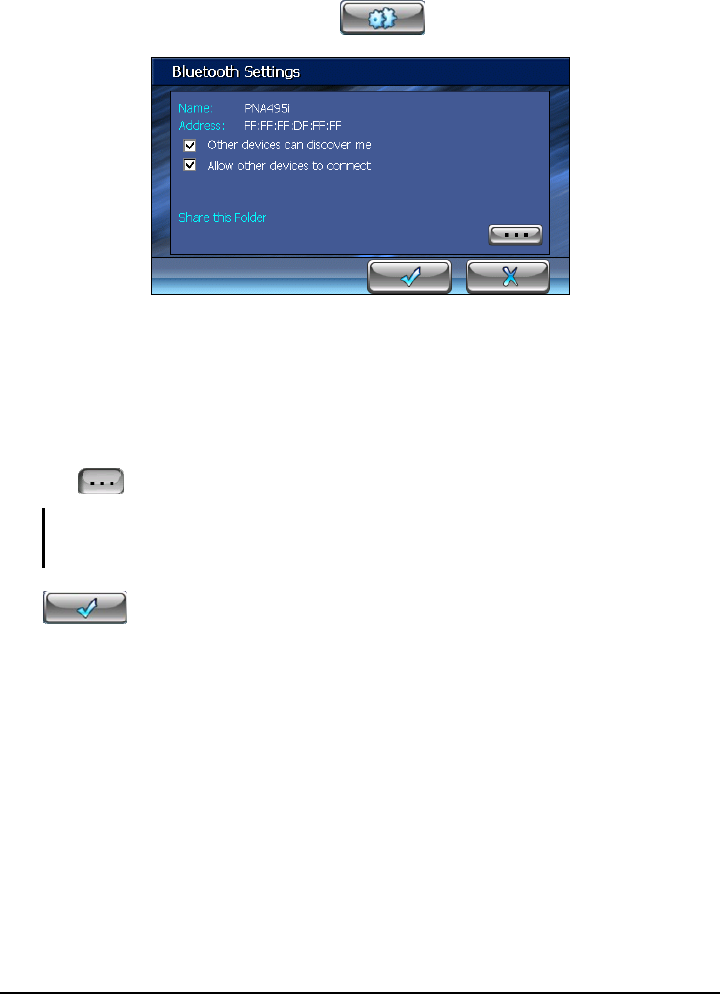
39
5.7 Configuring Bluetooth Settings
After starting Bluetooth Manager, tap to configure Bluetooth settings.
The available options are:
z Other devices can discover me
z Allow other devices to connect
z Share this Folder
Tap to specify the folder to share with the remote device.
NOTE: When you transfer picture files to your device via Bluetooth connection, the files are
transferred to this shared folder. Unless the files are in the correct location for the Pictures
program, the Pictures program cannot detect them.
Tap to save any changes you have made.
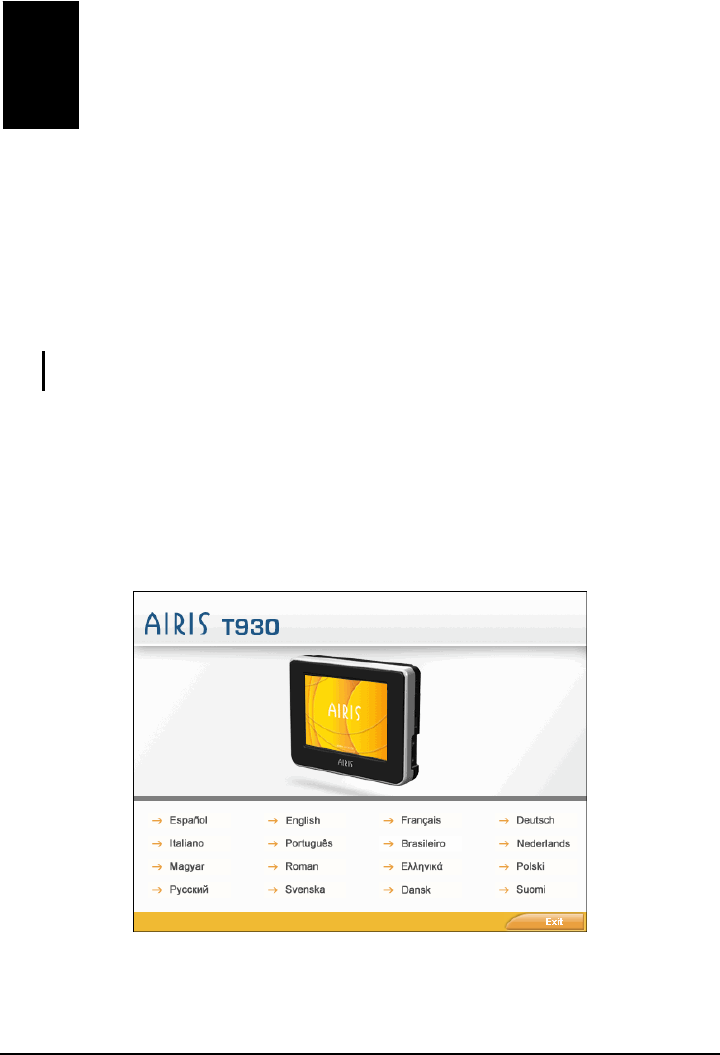
41
6 ActiveSync
6.1 About ActiveSync
ActiveSync allows you to establish the connection between your device and
computer.
CAUTION: During ActiveSync installation, do not connect your device to your computer
before the message on the screen asks you to.
Installing ActiveSync
1 Turn on your computer and your device.
2 Insert the provided DVD into the DVD drive of your computer. The auto run
screen appears.
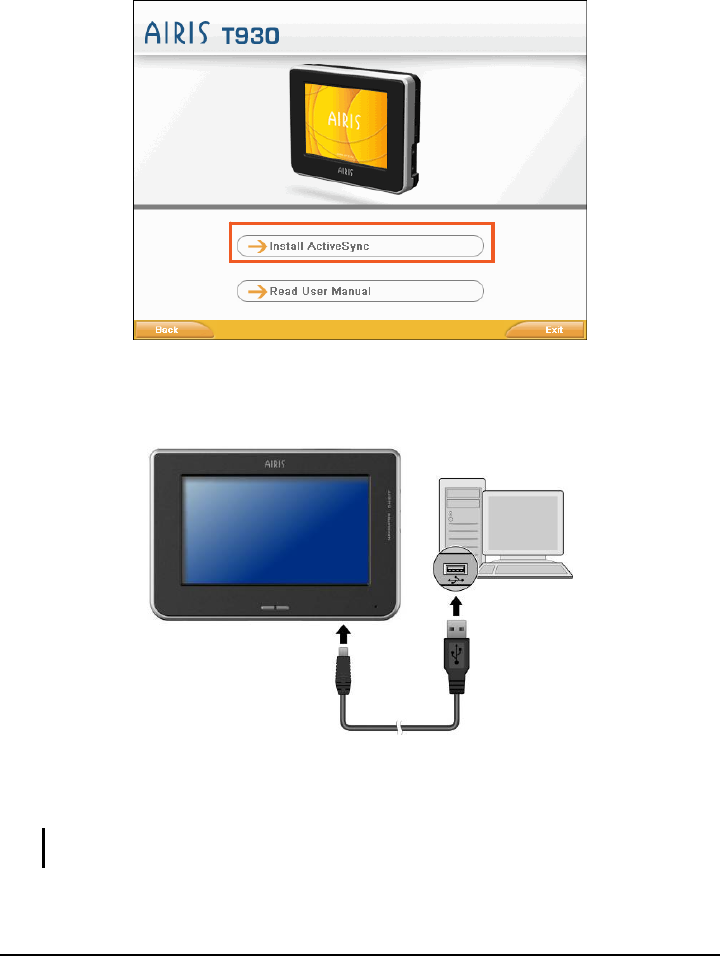
42
3 Click the Install button in the ActiveSync section. The installation wizard will
start automatically. Follow the onscreen instructions to finish the installation.
A status window indicates the progress of the installation.
4 When prompted, connect the mini-USB end of the USB cable to your device
and the other end to a USB port on your computer.
5 When the “Set up partnership” screen appears, select No and Next to connect as
a guest device.
NOTE: This device does not support synchronization with your computer. Therefore, you do
not need to set up a partnership.

43
Using ActiveSync
Once ActiveSync is installed on your computer, you can use it to transfer files
(i.e.pictures files) between your device and your computer.
CAUTION: Be discreet when you delete files from your device. Deleting files of which the
function is unknown can cause programs or features to malfunction.
Whenever you connect your device to your computer with the USB cable, the “Set
up partnership” screen appears. Always select No and Next to connect as a guest
device. Then you can use the Explorer function to browse the mobile device and
transfer data. (See the ActiveSync online Help for instructions on copying files.)
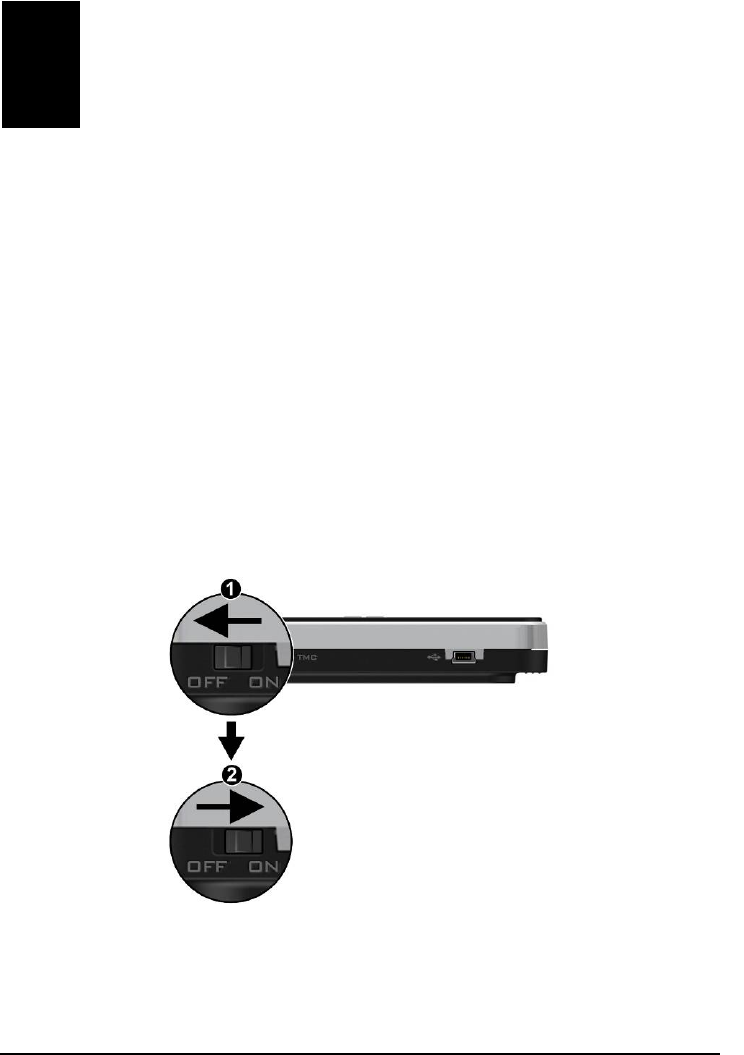
45
7 Troubleshooting and Maintenance
7.1 Reset and Restart
Reset Your System
Occasionally, you may need to reset your device. For example, you should reset
your system when it stops responding; or appears to be “frozen” or “locked up.”
You can use the following steps to perform a “hard reset.”
1. Disconnect all cables, including the charger, from your device.
2. Use a pointed pen to slide the ON/OFF switch to the OFF position.
3. Wait for 1 minute and then slide the switch back to the ON position.
Troubleshooting and
Maintenance
Wait for 1 minute.

46
Restarting Your Device
To restart your device, press the power button for 1 second until the “Power Off
Selection” screen appears and then tap Restart.
7.2 Troubleshooting
NOTE: If you encounter a problem you cannot solve, contact an authorized service center for
assistance.
Power Problems
Power does not turn on when using battery power
z The remaining battery power may be too low to run your device. Charge the
battery.
Screen Problems
Screen responds slowly
z Make sure that your device is not running out of battery power. If the problem
still exists, reset your system.
Screen freezes
z Reset your system.
Screen is hard to read
z Make sure that the backlight of the display is on.
z Move to a location with more light.
Inaccurate response to taps
z Recalibrate the touch screen.

47
Connection Problems
Cable Connection Problems
z Make sure that your device and your computer are both turned on before
trying to establish a connection.
z Make sure that the cable is securely plugged into the USB port on your
computer and on the device. Connect the USB cable directly to your
computer—do not run the cable through a USB hub.
z Reset your device before connecting the cable. Always disconnect your
device before you restart your computer.
GPS Problems
z When there are no valid signals available, consider the following:
z Make sure that the GPS antenna has a clear view of the sky.
z Note that the GPS reception can be affected by:
9 Bad weather
9 Dense overhead obstacles (e.g. trees and tall buildings)
9 Other wireless device in the car
9 Reflective car window tint
7.3 Maintaining Your Device
Taking good care of your device will ensure trouble-free operation and reduce the
risk of damage to your device.
z Keep your device away from excessive moisture and extreme temperatures.
z Avoid exposing your device to direct sunlight or strong ultraviolet light for
extended periods of time.
z Do not place anything on top of your device or drop objects on your device.
z Do not drop your device or subject it to severe shock.
z Do not subject your device to sudden and severe temperature changes. This
could cause moisture condensation inside the unit, which could damage your

48
device. In the event of moisture condensation, allow the device to dry out
completely before use.
z Take care not to sit on the device. We advise not to carry the device in one’s
back pocket for that reason.
z The screen surface can easily be scratched. Avoid touching it with sharp
objects. Non-adhesive generic screen protectors designed specifically for use
on portable devices with LCD panels may be used to help protect the screen
from minor scratches.
z Never clean your device with it powered on. Use a soft, lint-free cloth
moistened with water to wipe the screen and the exterior of your device.
z Do not use paper towels to clean the screen.
z Never attempt to disassemble, repair or make any modifications to your
device. Disassembly, modification or any attempt at repair could cause
damage to your device and even bodily injury or property damage and will
void any warranty.
z Do not store or carry flammable liquids, gases or explosive materials in the
same compartment as your device, its parts or accessories.

49
8 Regulatory Information
NOTE: Marking labels located on the exterior of your device indicate the regulations that
your model complies with. Please check the marking labels on your device and refer to the
corresponding statements in this chapter. Some notices apply to specific models only.
8.1 Regulations Statements
FCC Regulatory information / Disclaimers
Installation and use of this Portable Navigator must be in strict accordance with
the instructions included in the user documentation provided with the product.
Any changes or modifications (including the antennas) made to this device that
are not expressly approved by the manufacturer may void the user’s authority to
operate the equipment. The manufacturer is not responsible for any radio or
television interference caused by unauthorized modification of this device, or the
substitution of the connecting cables and equipment other than manufacturer
specified. It is the responsibility of the user to correct any interference caused by
such unauthorized modification, substitution or attachment. Manufacturer and its
authorized resellers or distributors will assume no liability for any damage or
violation of government regulations arising from failing to comply with these
guidelines.
This device complies with Part 15 of the FCC Rules. Operation is subject to the
following two conditions:
z This device may not cause harmful interference.
z This device must accept any interference received, including interference that
may cause undesired operation.

50
European Notice
Products with the CE marking comply with Radio & Telecommunication
Terminal Equipment Directive (R&TTE) (1999/5/EEC), the Electromagnetic
Compatibility Directive (89/336/EEC) and the Low Voltage Directive
(73/23/EEC) – as amended by Directive 93/68/ECC - issued by the Commission
of the European Community.
Compliance with these directives implies conformity to the following European
Standards:
EN301489-1&EN301489-19: Electronic compatibility and Radio spectrum
Matters (ERM),ElectroMagnetic Compatibility (EMC) standard for radio
equipment and services;
Part 1: Common technical requirements
EN55022: Radio disturbance characteristics
EN55024: Immunity characteristics
EN6100-3-2: Limits for harmonic current emissions
EN6100-3-3: Limitation of voltage fluctuation and flicker in low-voltage supply
system
EN60950 / IEC 60950: Product Safety
EN300328: Electromagnetic compatibility and Radio spectrum matters (ERM);
Wideband transmission systems; Data transmission equipment operating in the
2.4GHz ISM band and using wide band modulation techniques; Harmonized EN
covering essential requirements under article 3.2 of the R&TTE Directive
The manufacturer cannot be held responsible for modifications made by the User
and the consequences thereof, which may alter the conformity of the product with
the CE Marking.

51
8.2 Safety Precautions
z Prolonged listening of music in maximum volume can damage the ears.
z The use of headphones other than those recommended/supplied can cause
hearing impairment due to excessive sound pressure.
About Charging
z Use only the charger supplied with your device. Use of another type of
charger will result in malfunction and/or danger.
z This product is intended to be supplied by a LISTED Power Unit marked with
“LPS”, “Limited Power Source” and output rated + 5 V dc / 1.0 A”.
z Use a specified battery in the equipment.
About the Charger
z Do not use the charger in a high moisture environment. Never touch the
charger when your hands or feet are wet.
z Allow adequate ventilation around the charger when using it to operate the
device or charge the battery. Do not cover the charger with paper or other
objects that will reduce cooling. Do not use the charger while it is inside a
carrying case.
z Connect the charger to a proper power source. The voltage requirements are
found on the product case and/or packaging.
z Do not use the charger if the cord becomes damaged.
z Do not attempt to service the unit. There are no serviceable parts inside.
Replace the unit if it is damaged or exposed to excess moisture.
About the Battery
z Use a specified charger approved by the manufacturer.
CAUTION: This unit contains a non-replaceable internal Lithium Ion battery. The battery can
burst or explode, releasing hazardous chemicals. To reduce the risk of fire or burns, do not
disassemble, crush, puncture, or dispose of in fire or water.
z Important instructions (for service personnel only)
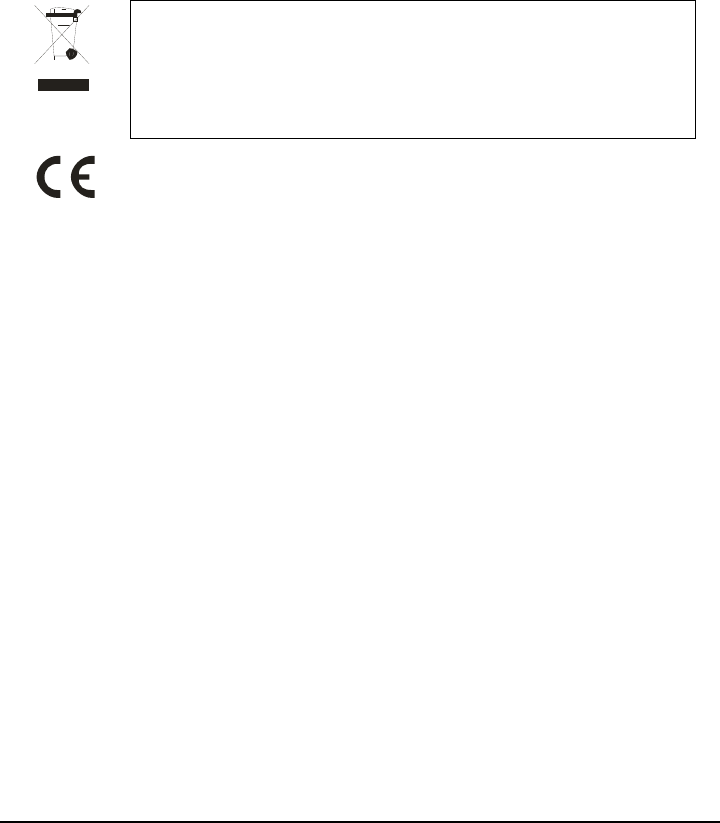
52
9 Caution: Risk of explosion if battery is replaced by an incorrect type.
Dispose of used batteries according to the instructions.
9 Replace only with the same or equivalent type recommended by the
manufacturer.
9 The battery must be recycled or disposed of properly.
9 Use the battery only in the specified equipment.
Additional Information
If you want to dispose this product, do not mix it with general
household waste. There is a separate collection system for
used electronic products in accordance with legislation that
requires proper treatment, recovery and recycling.